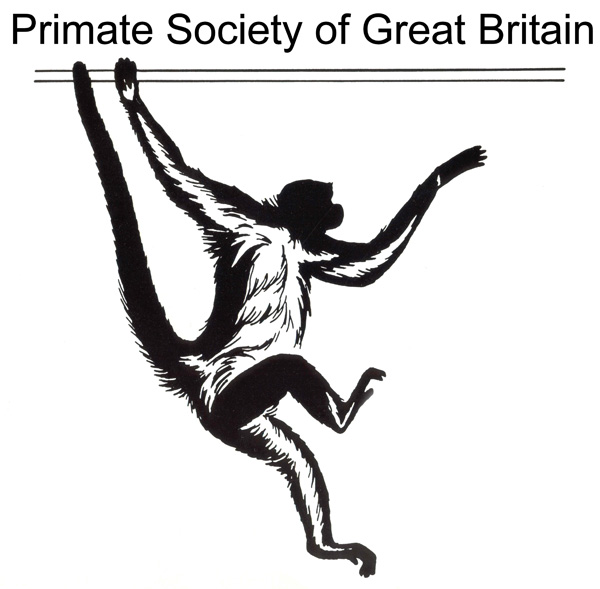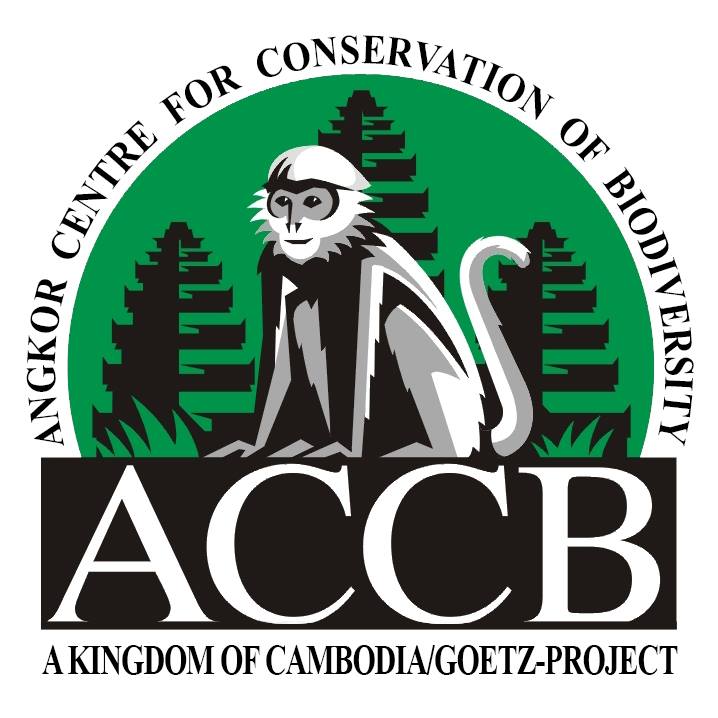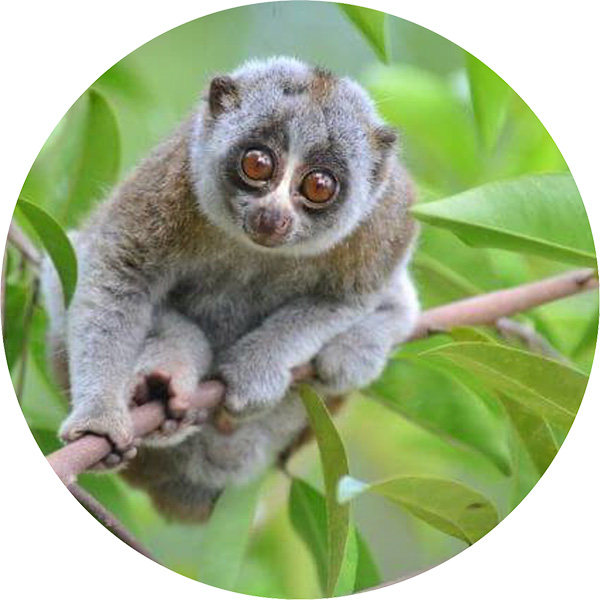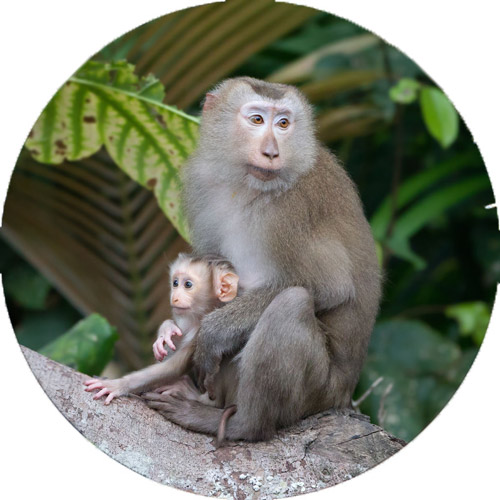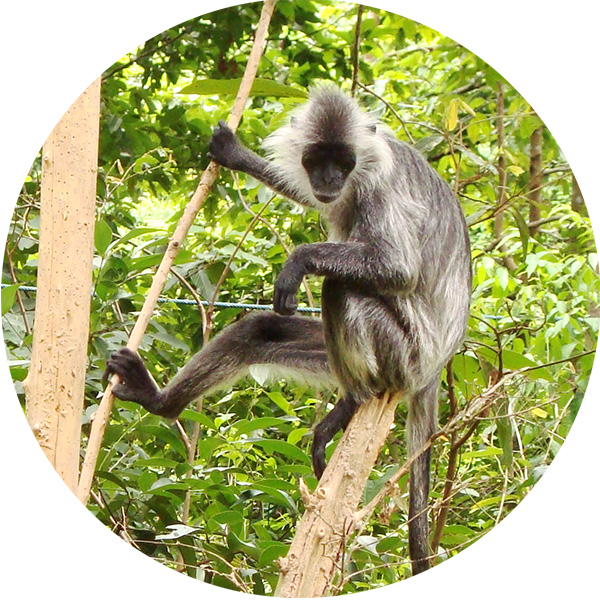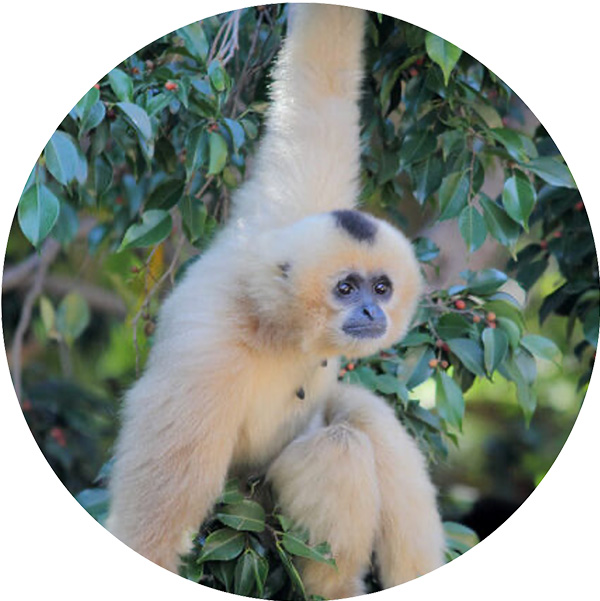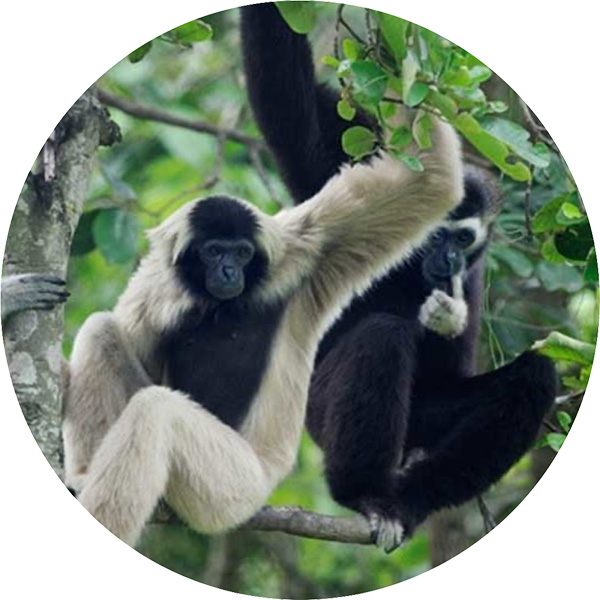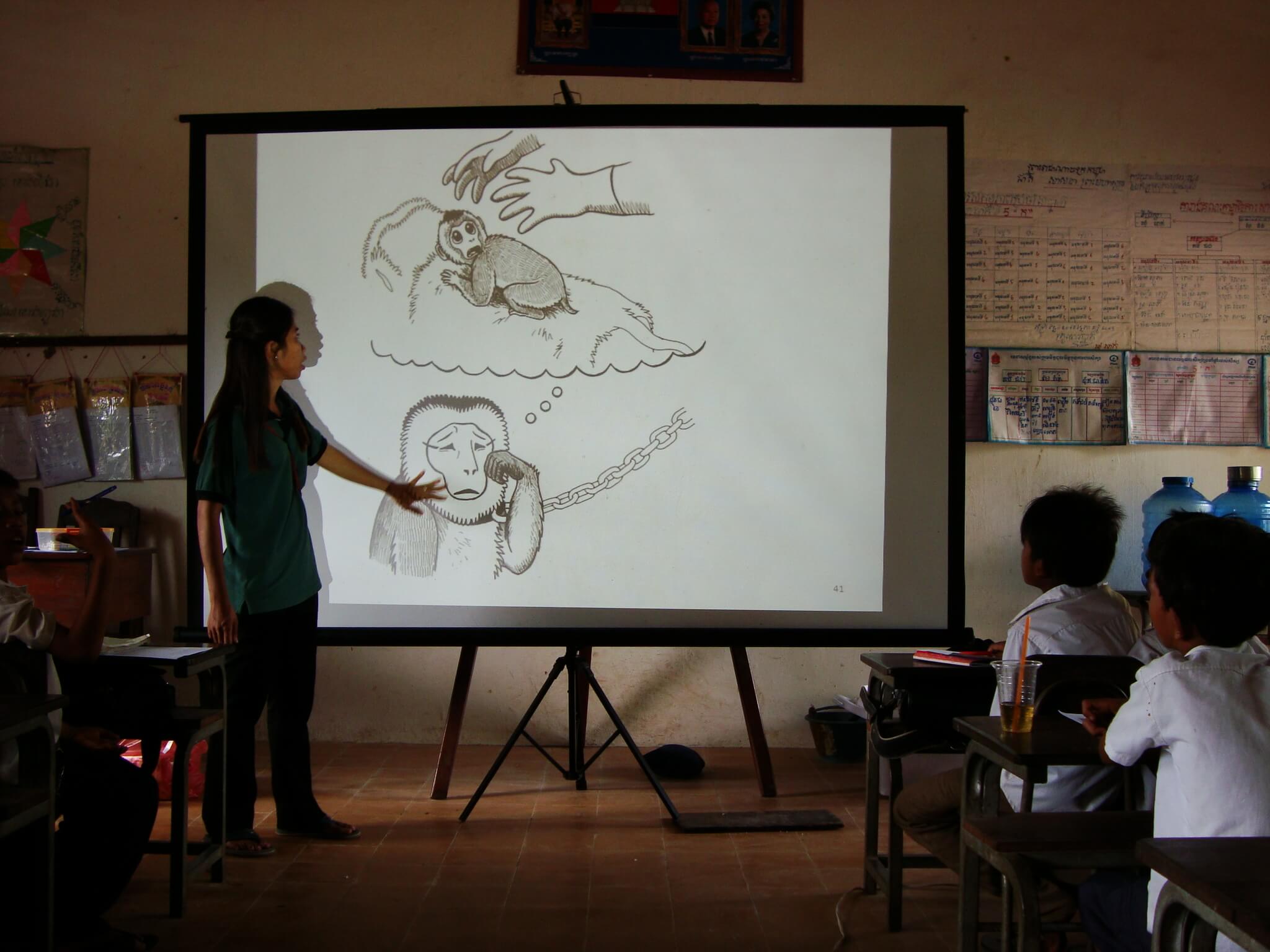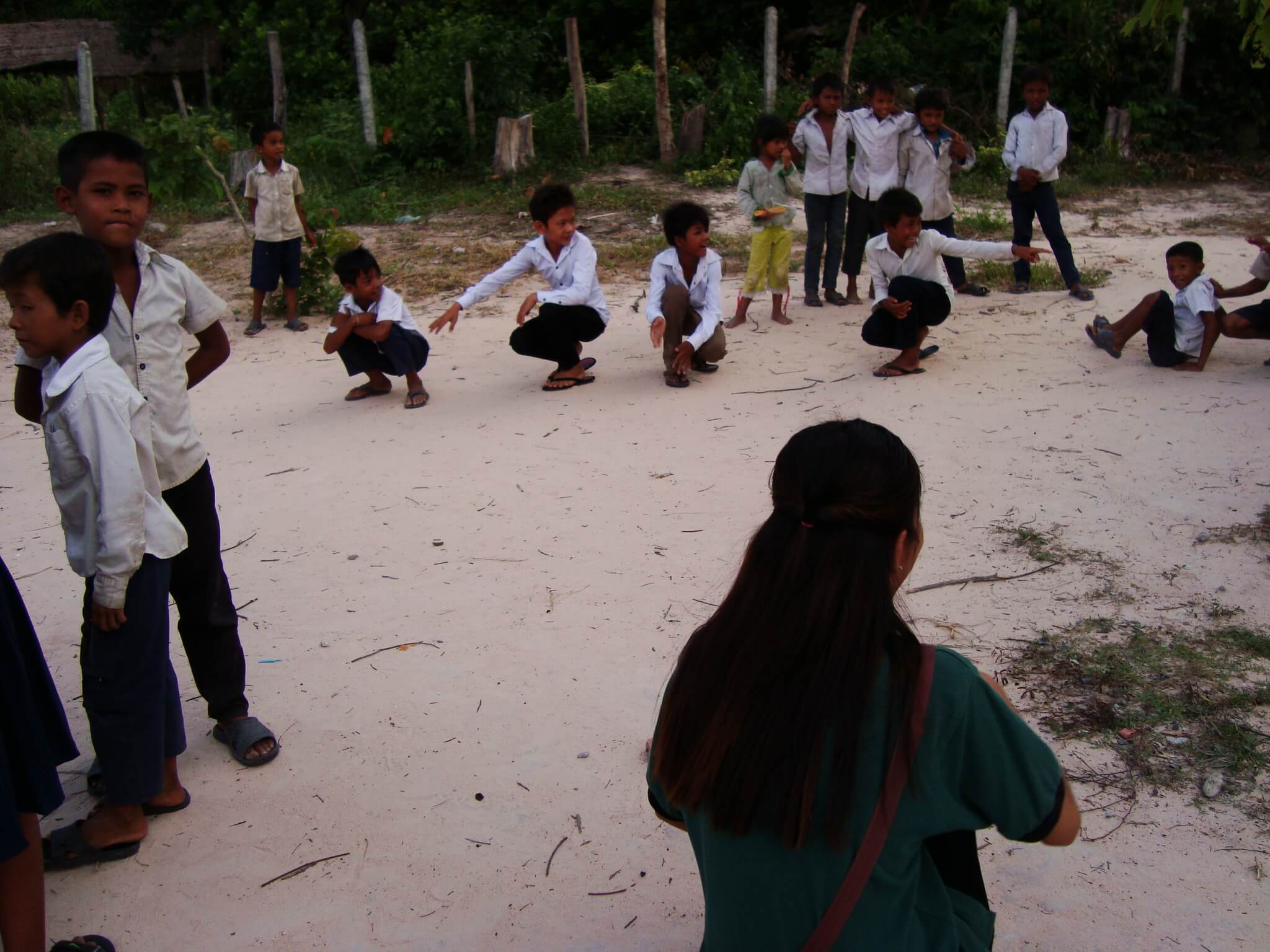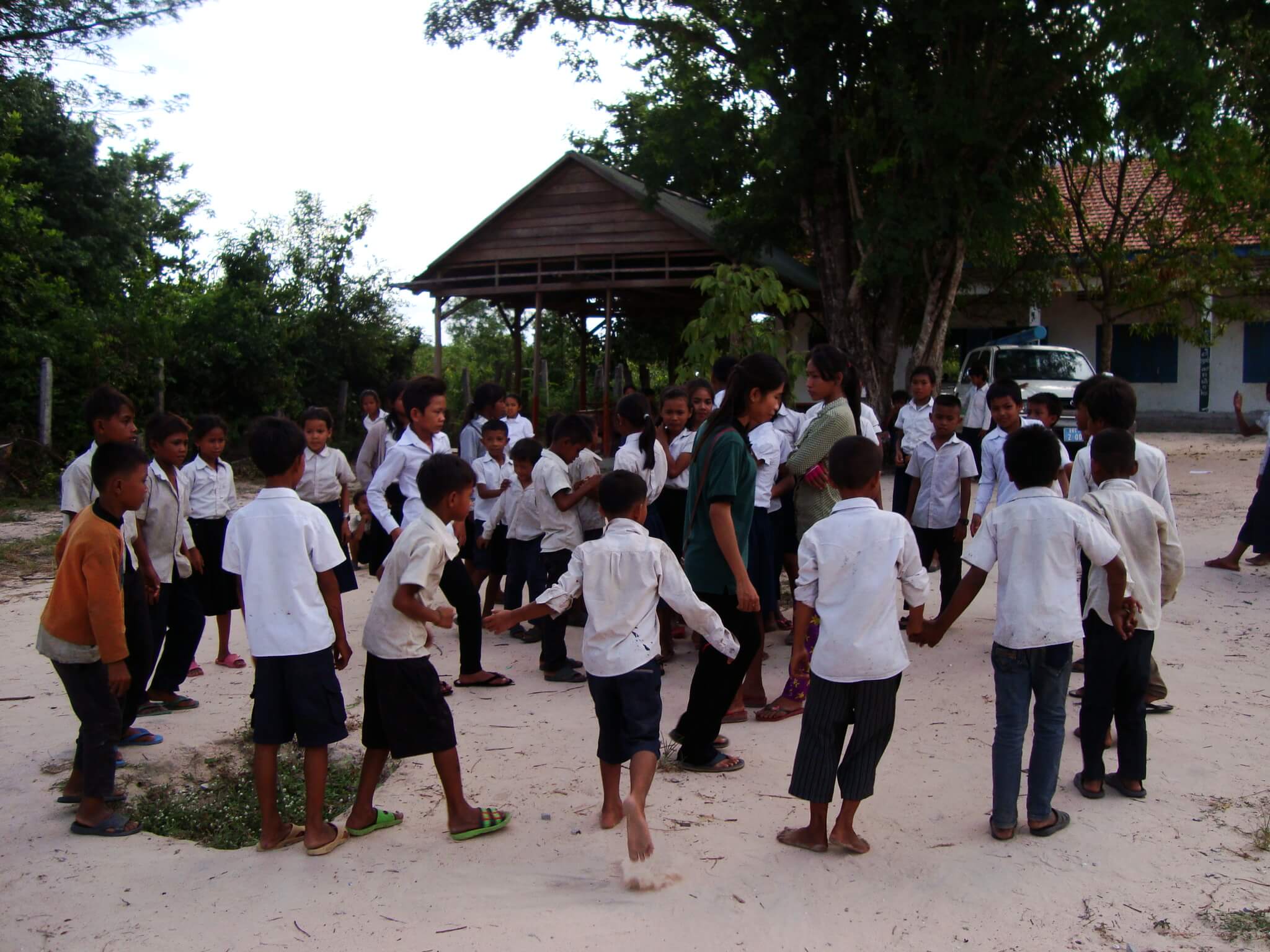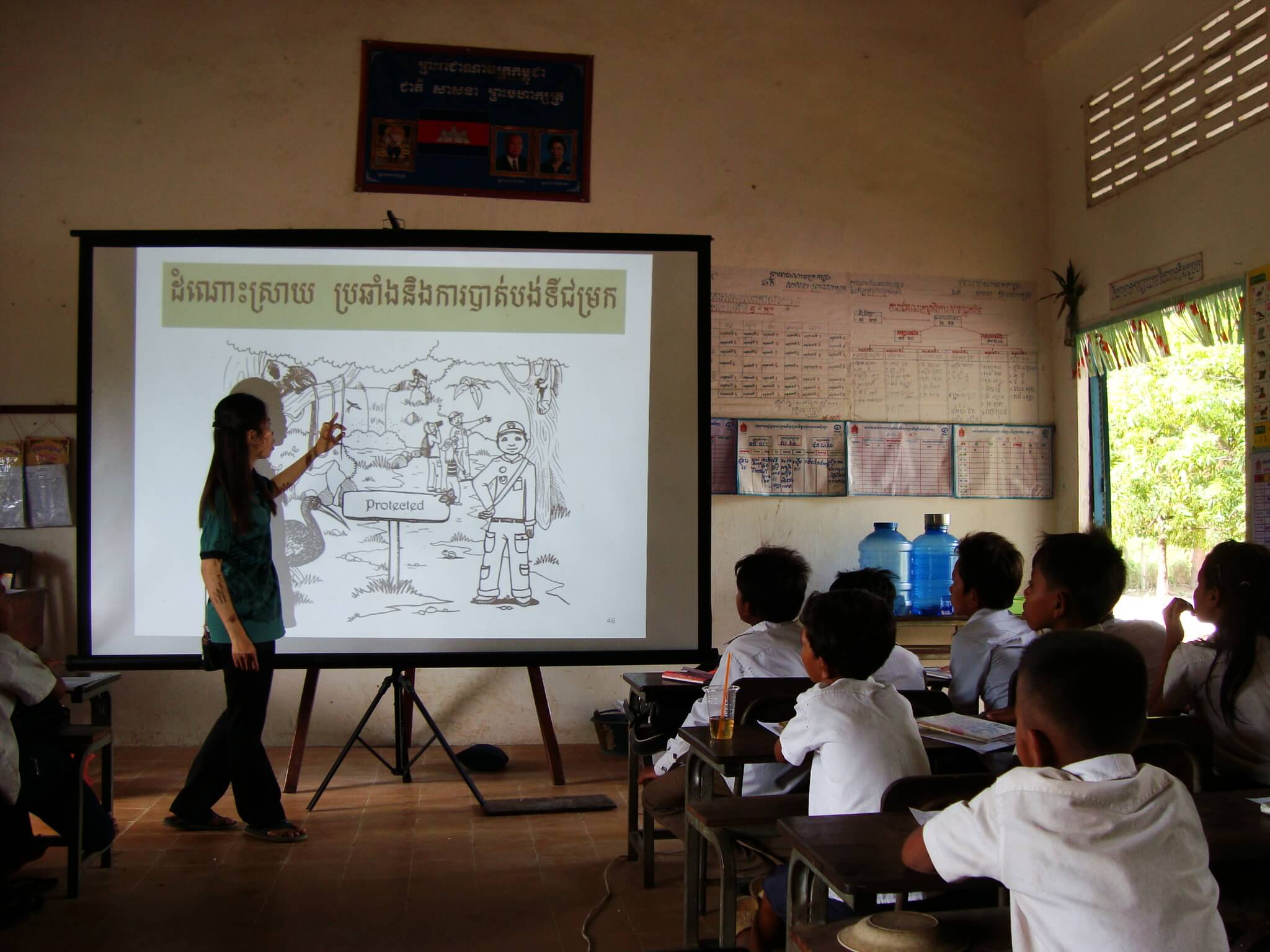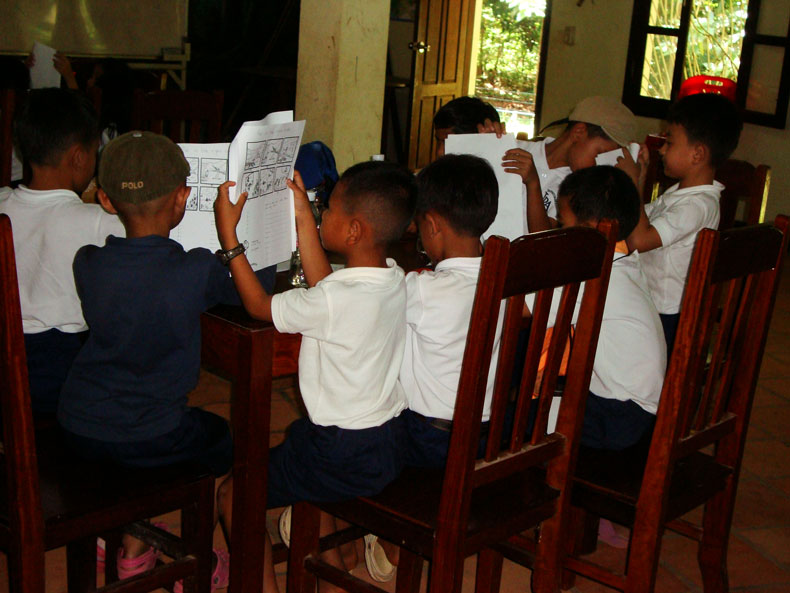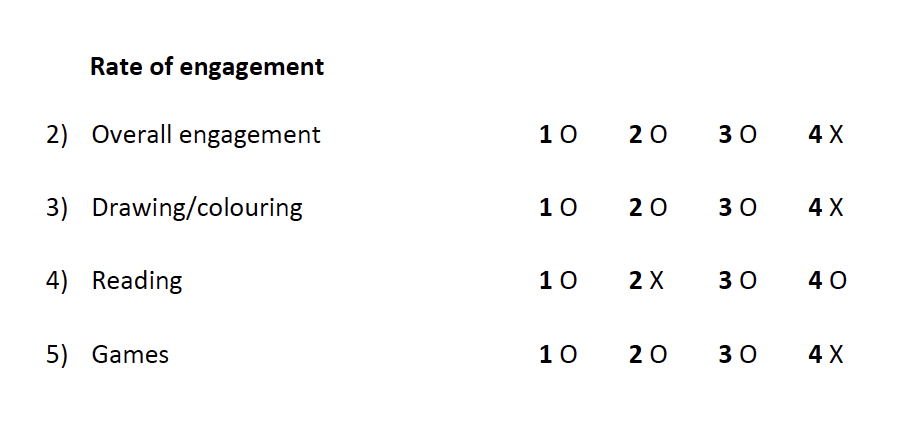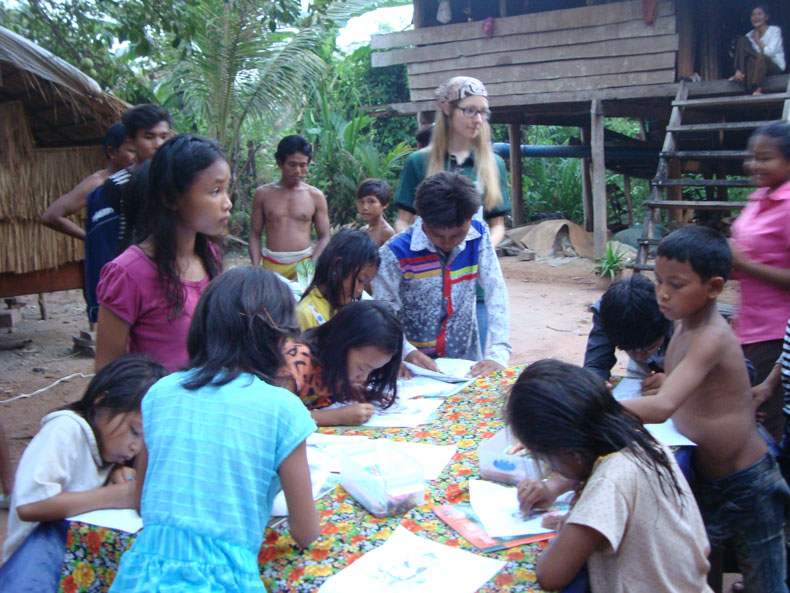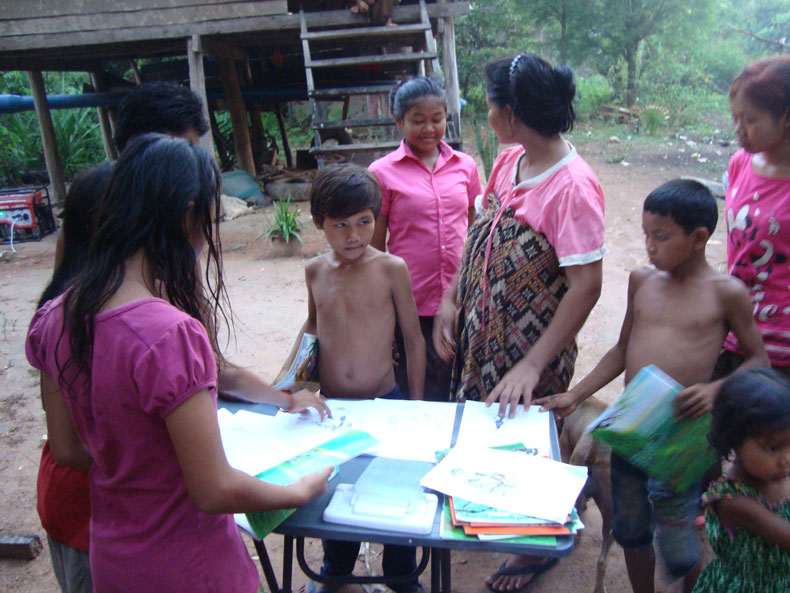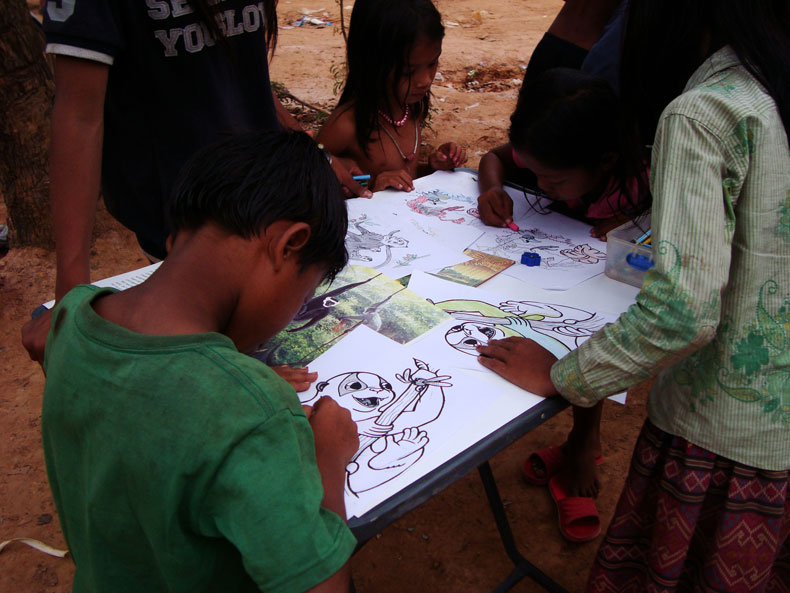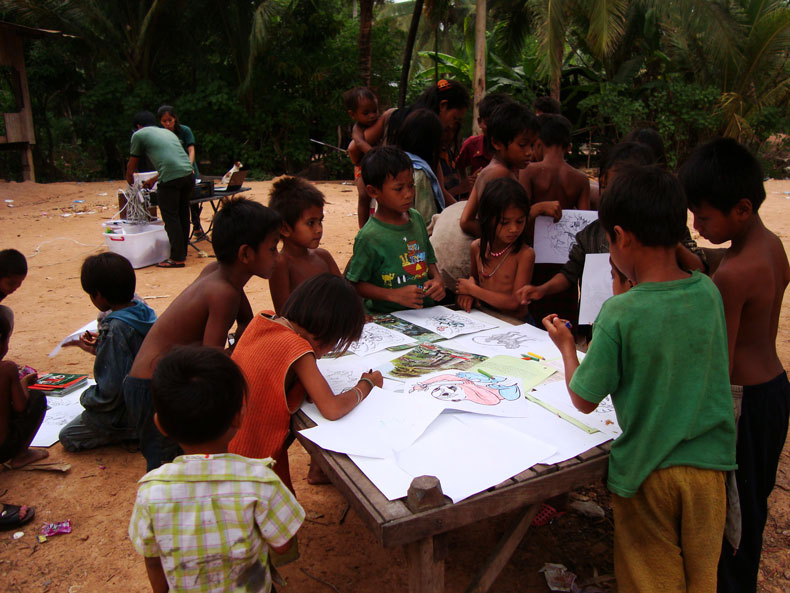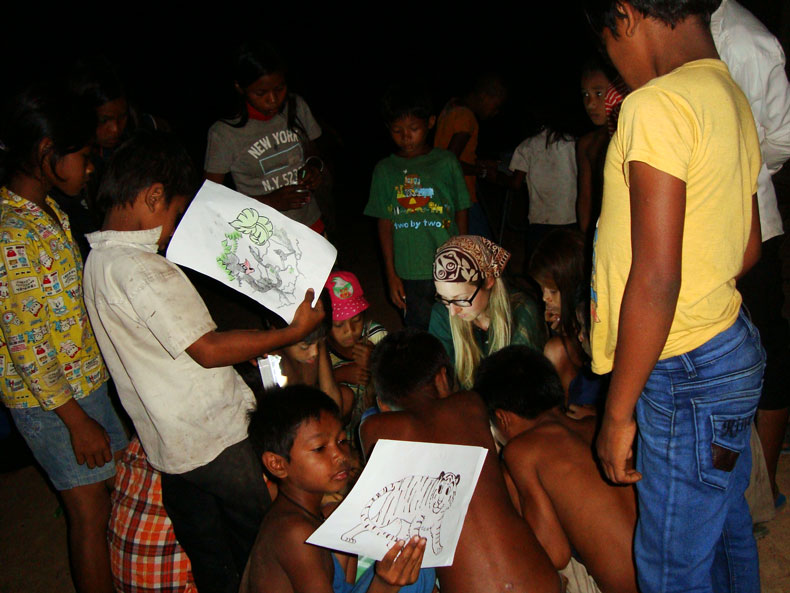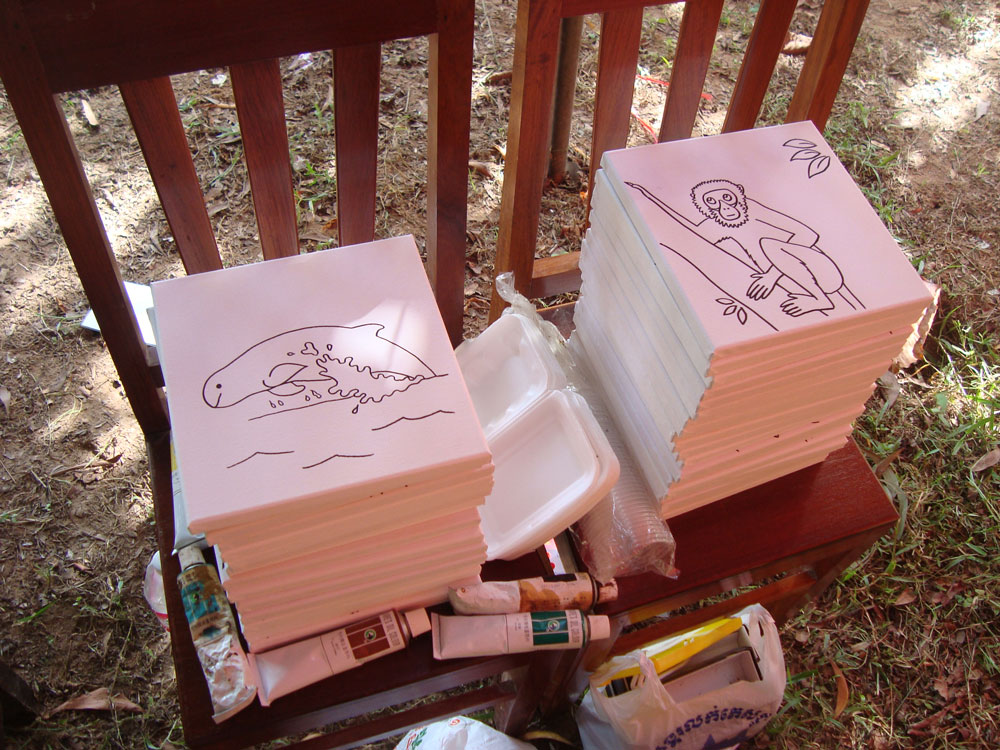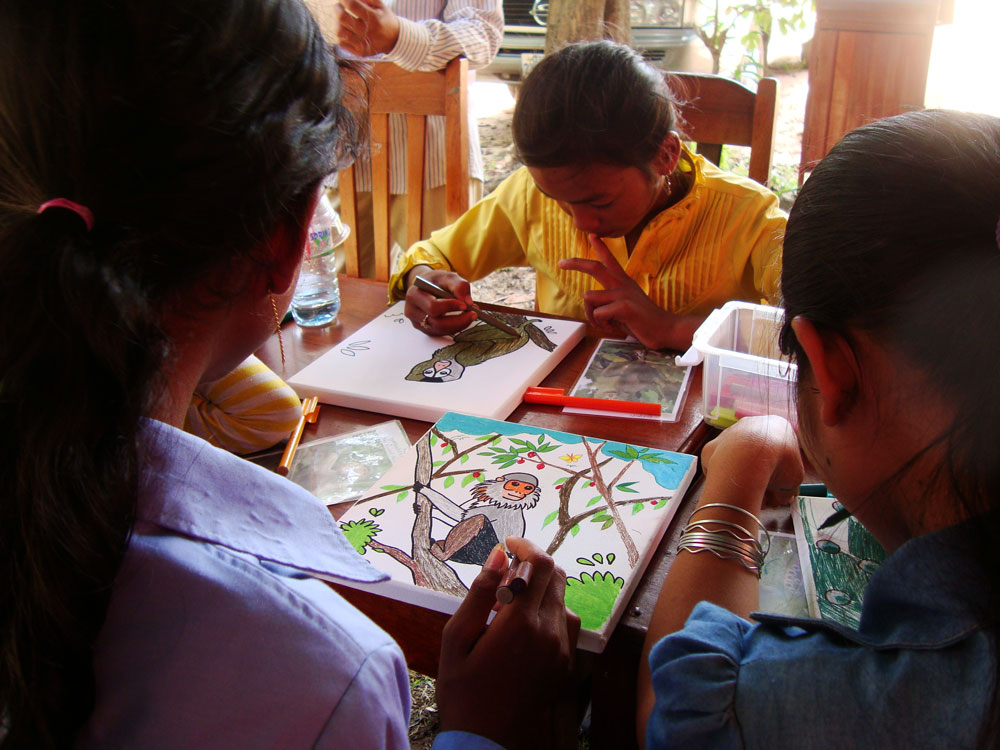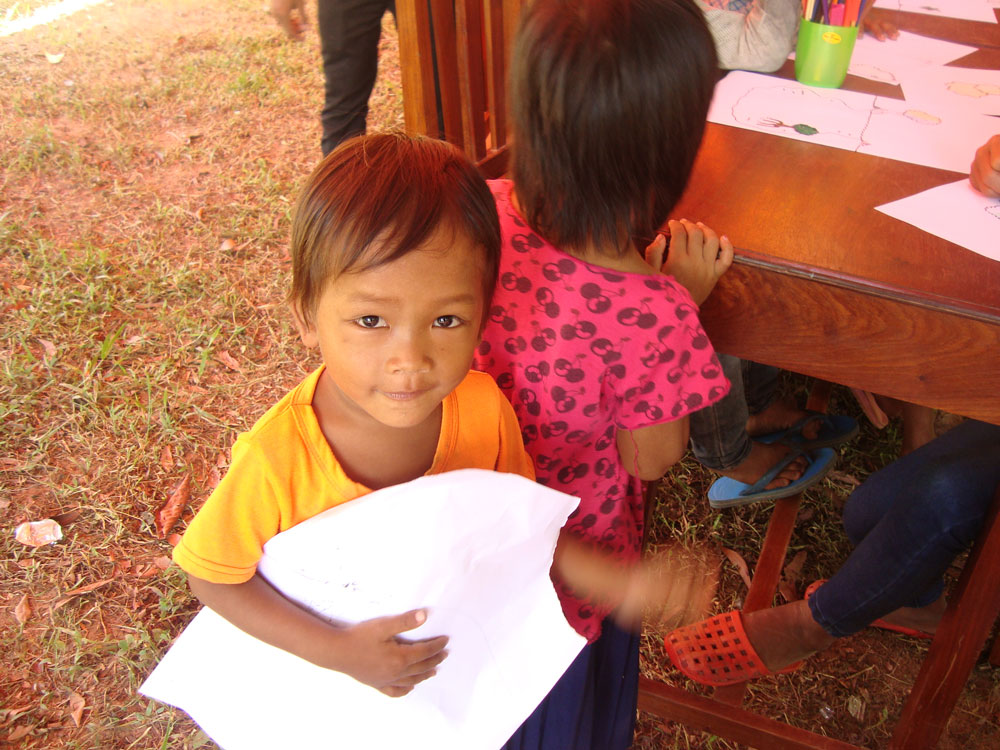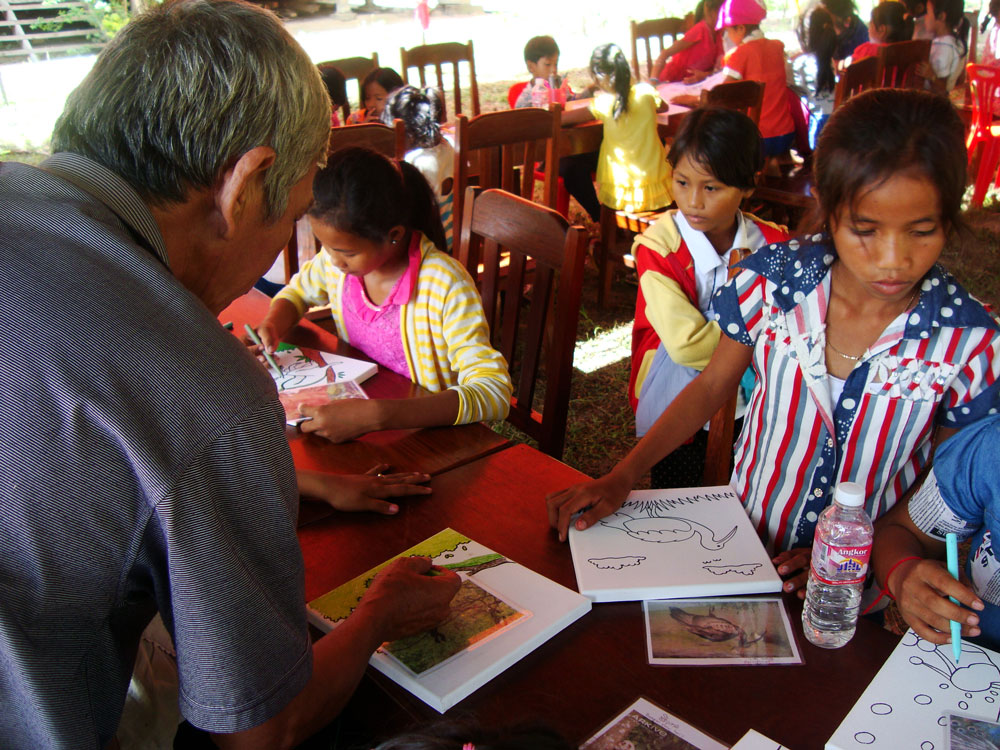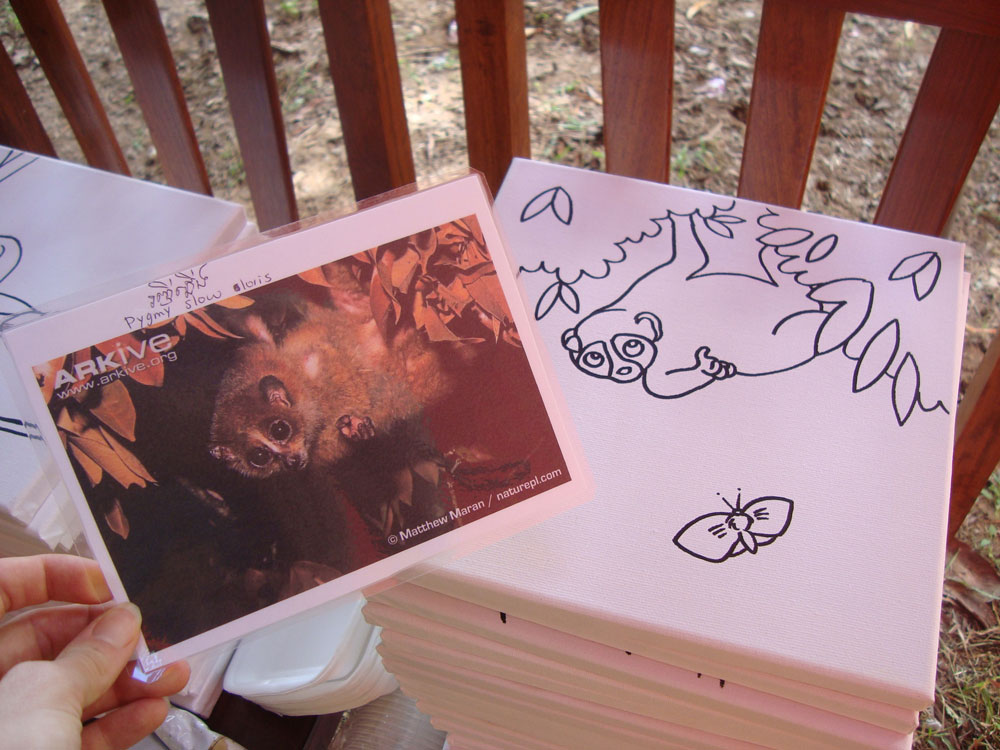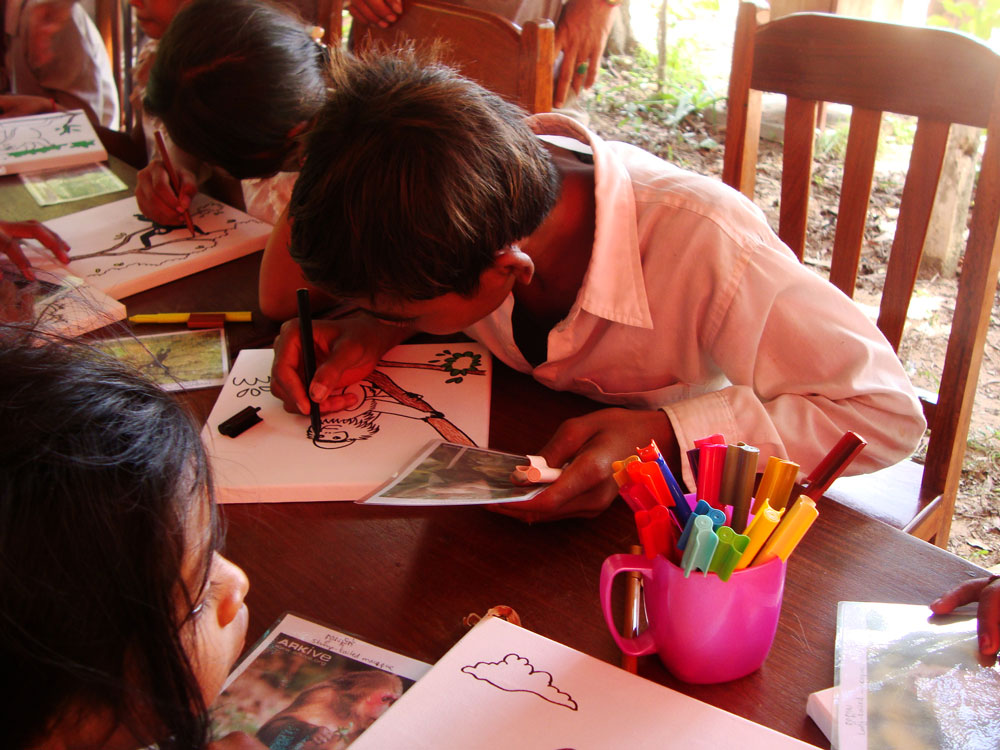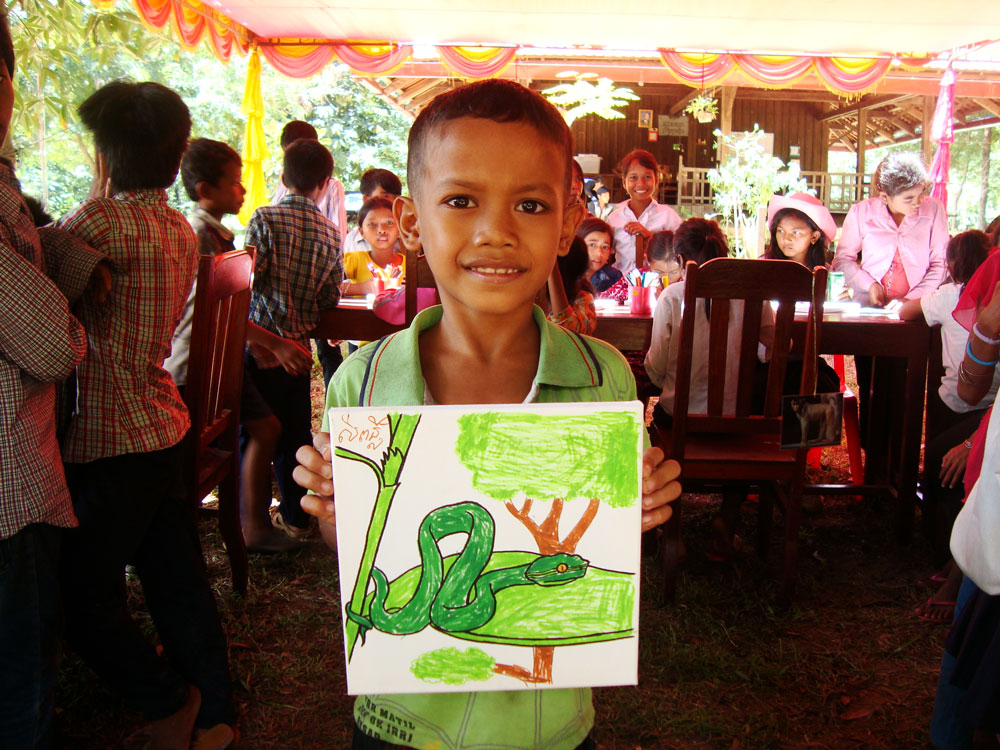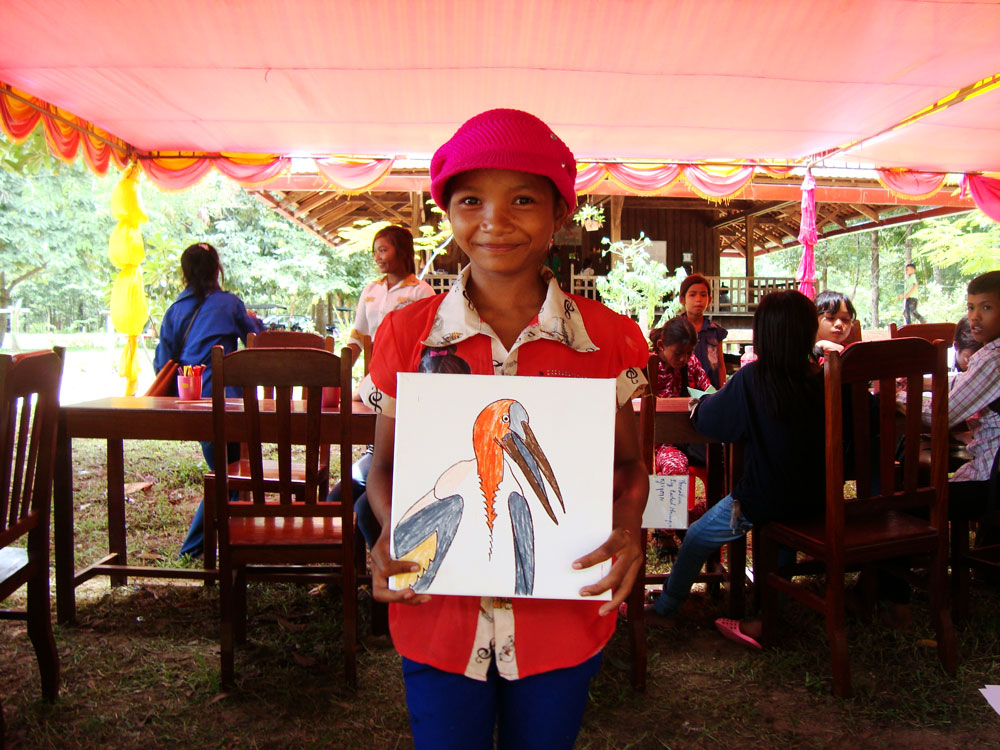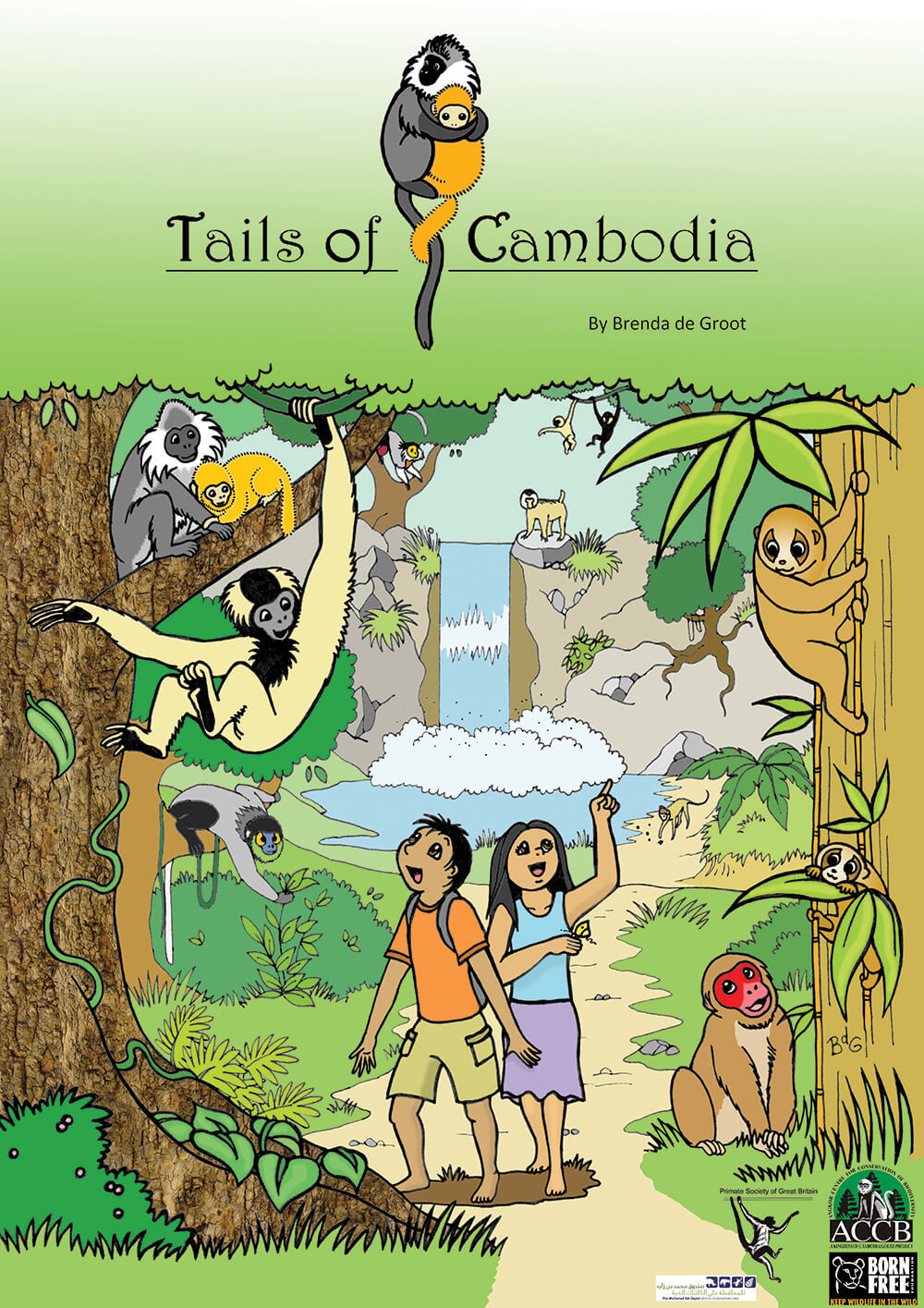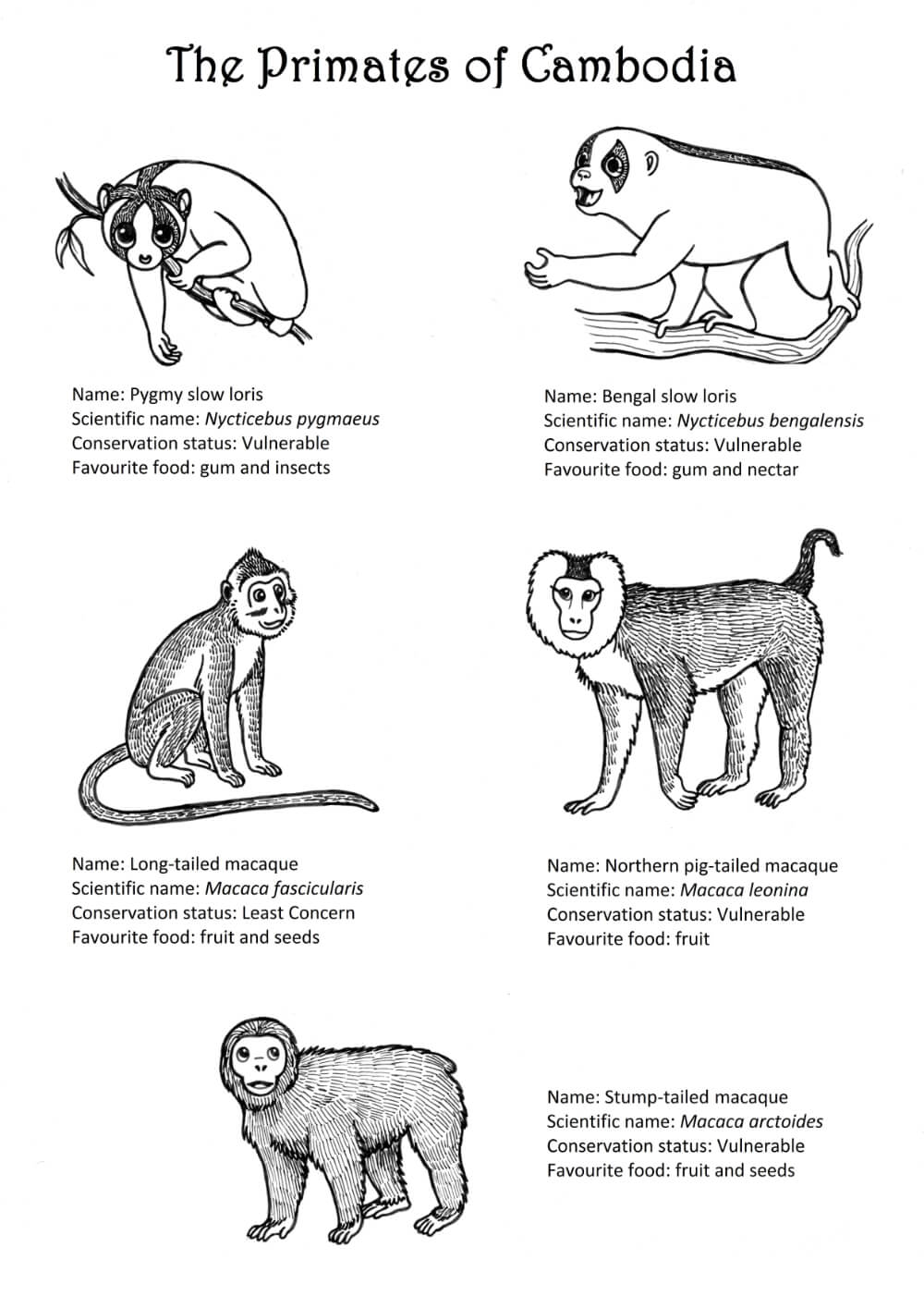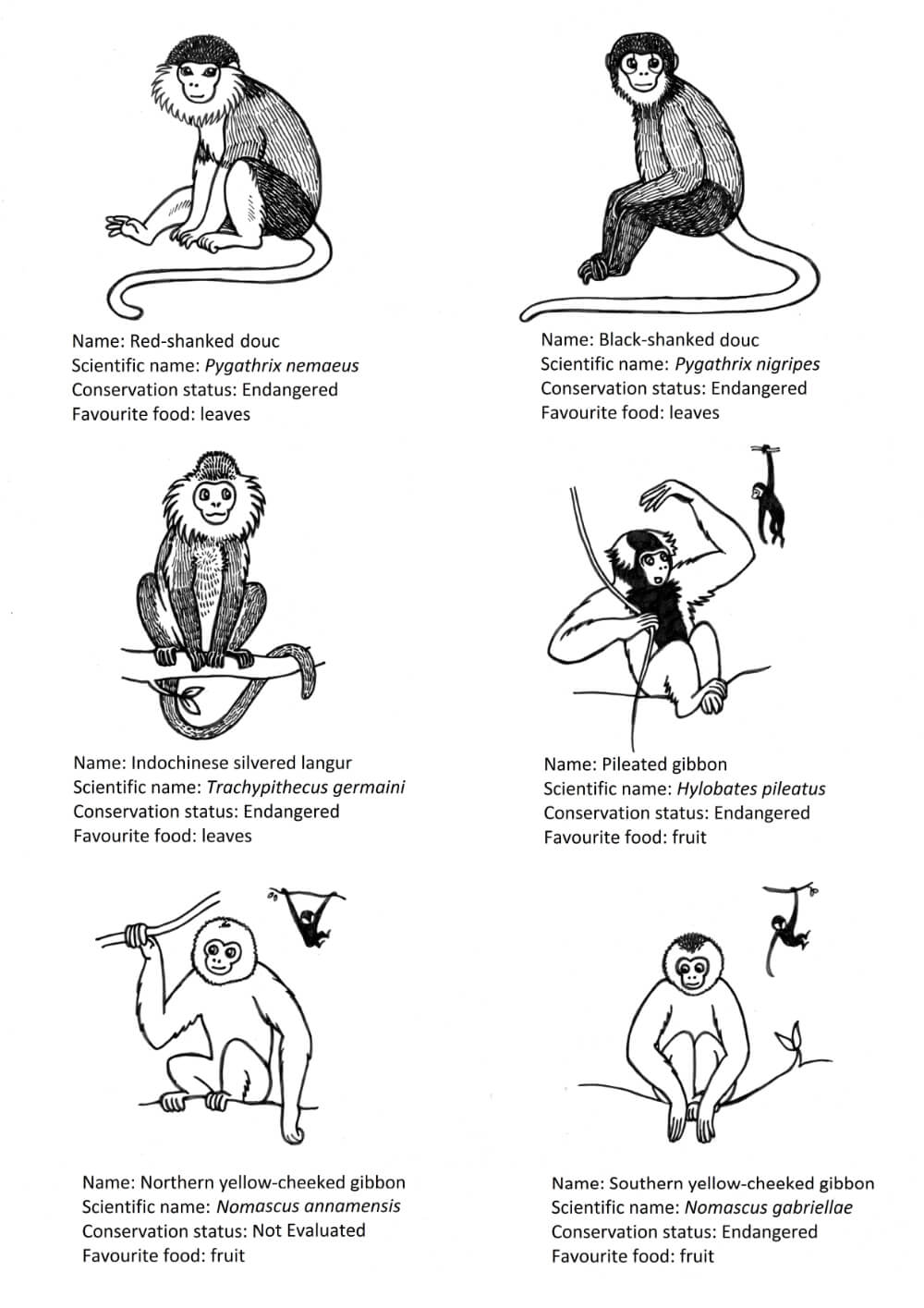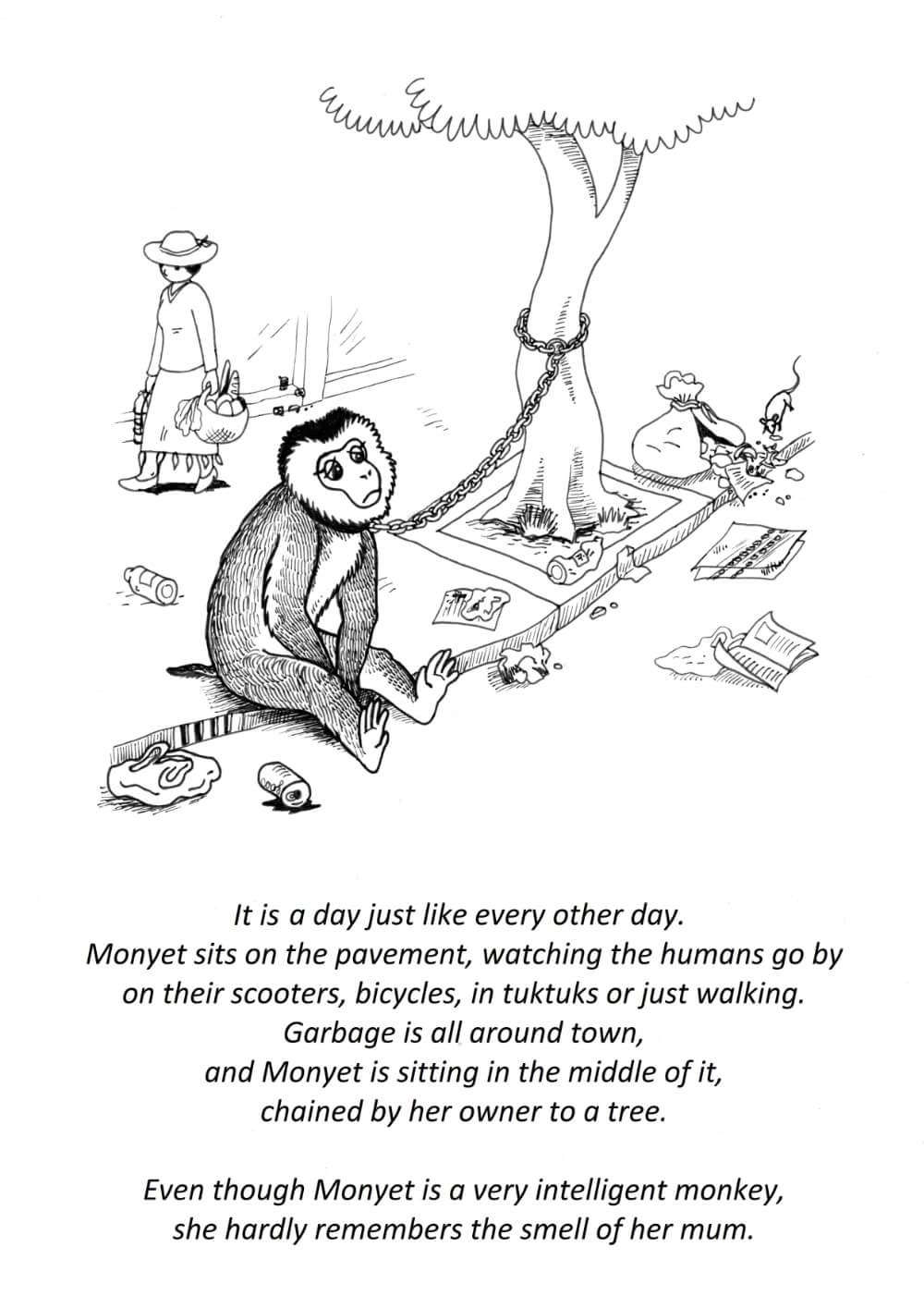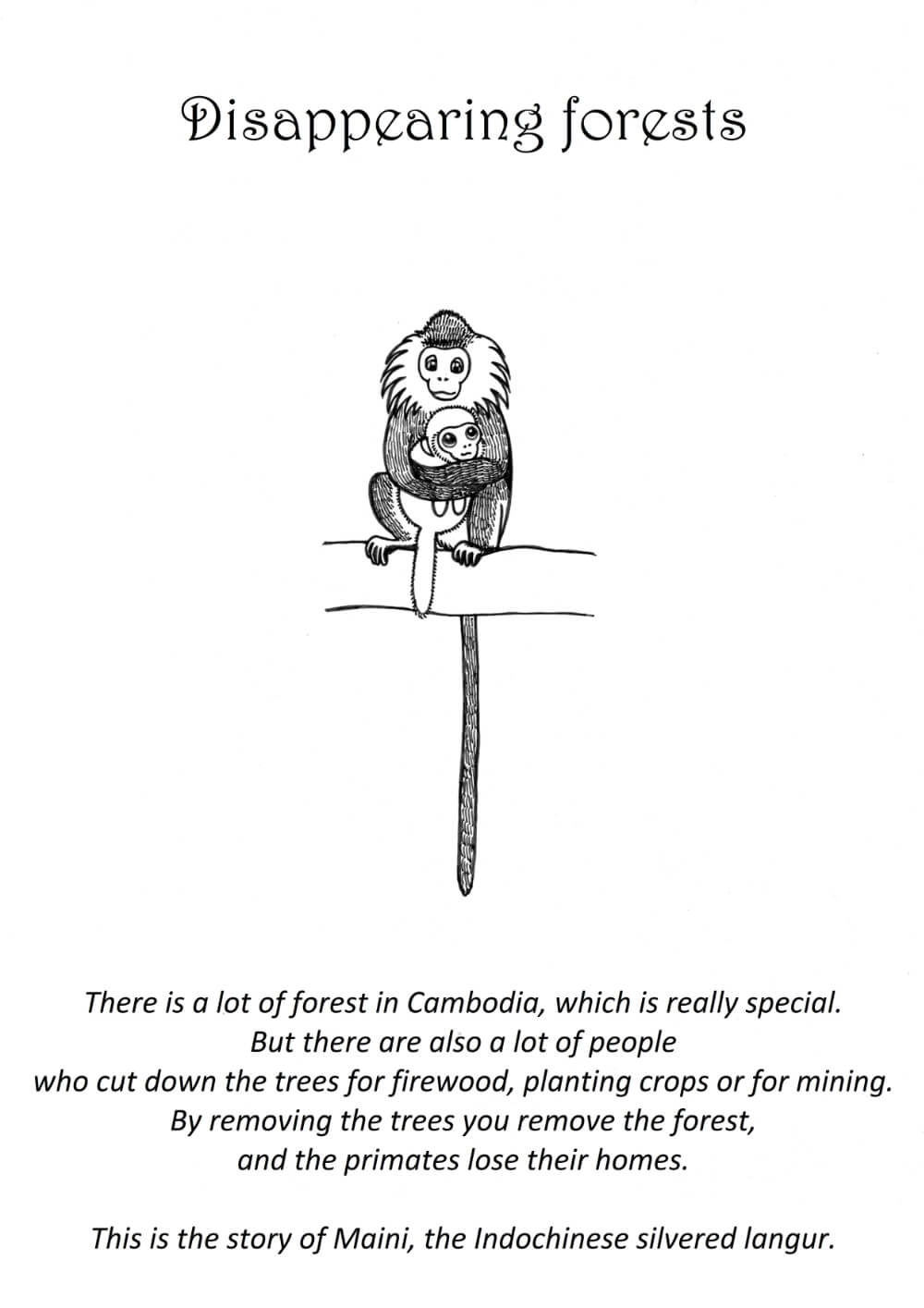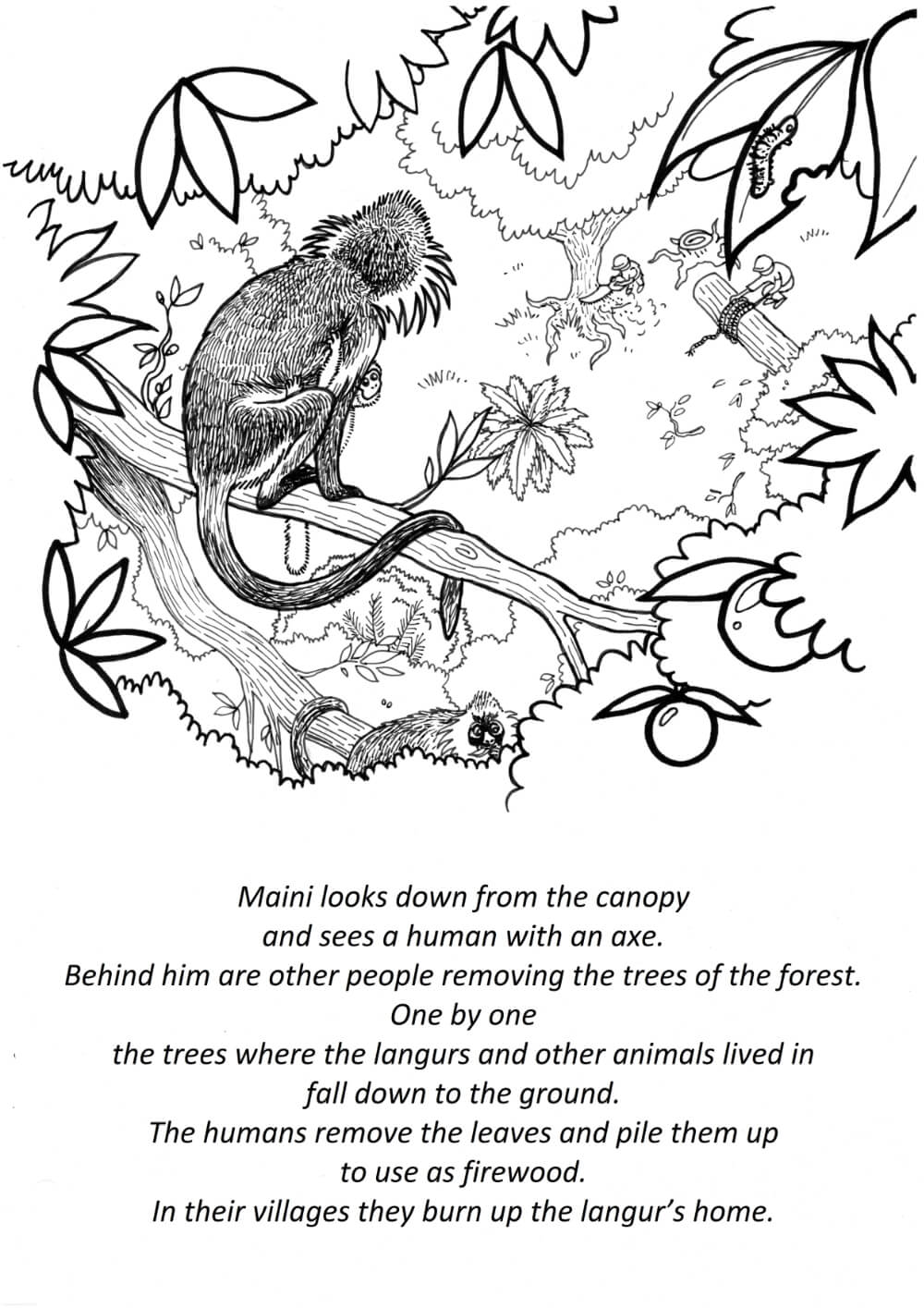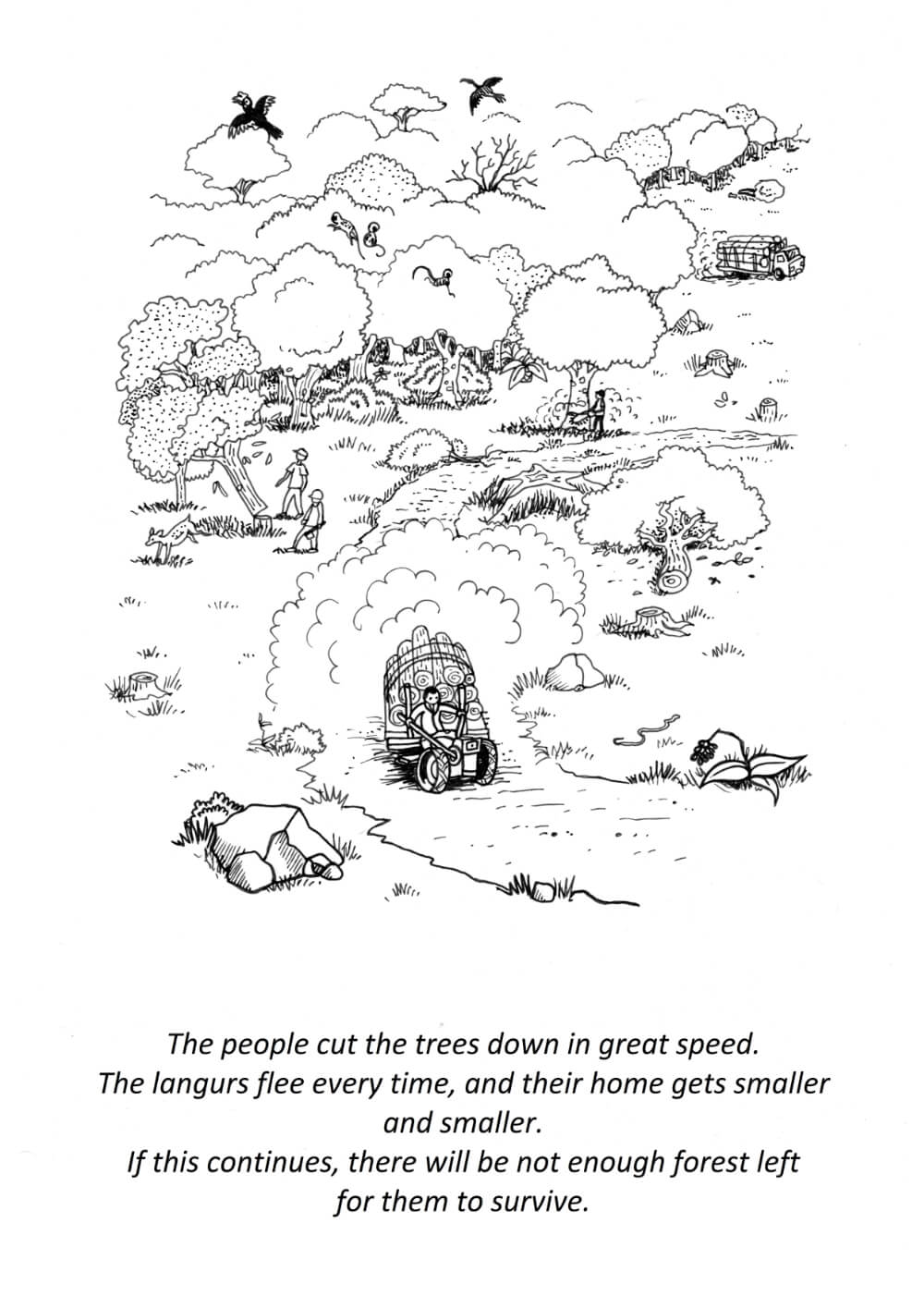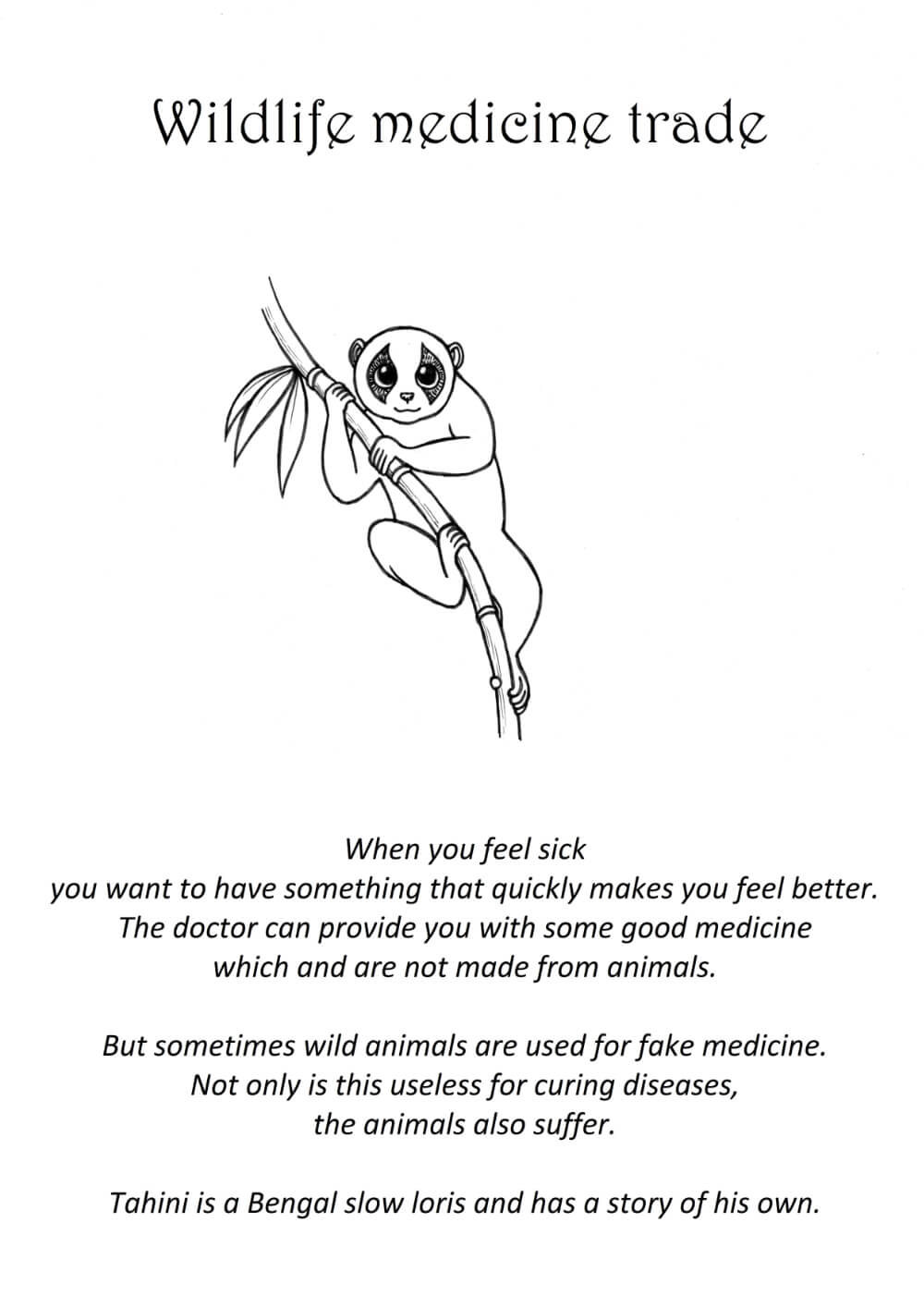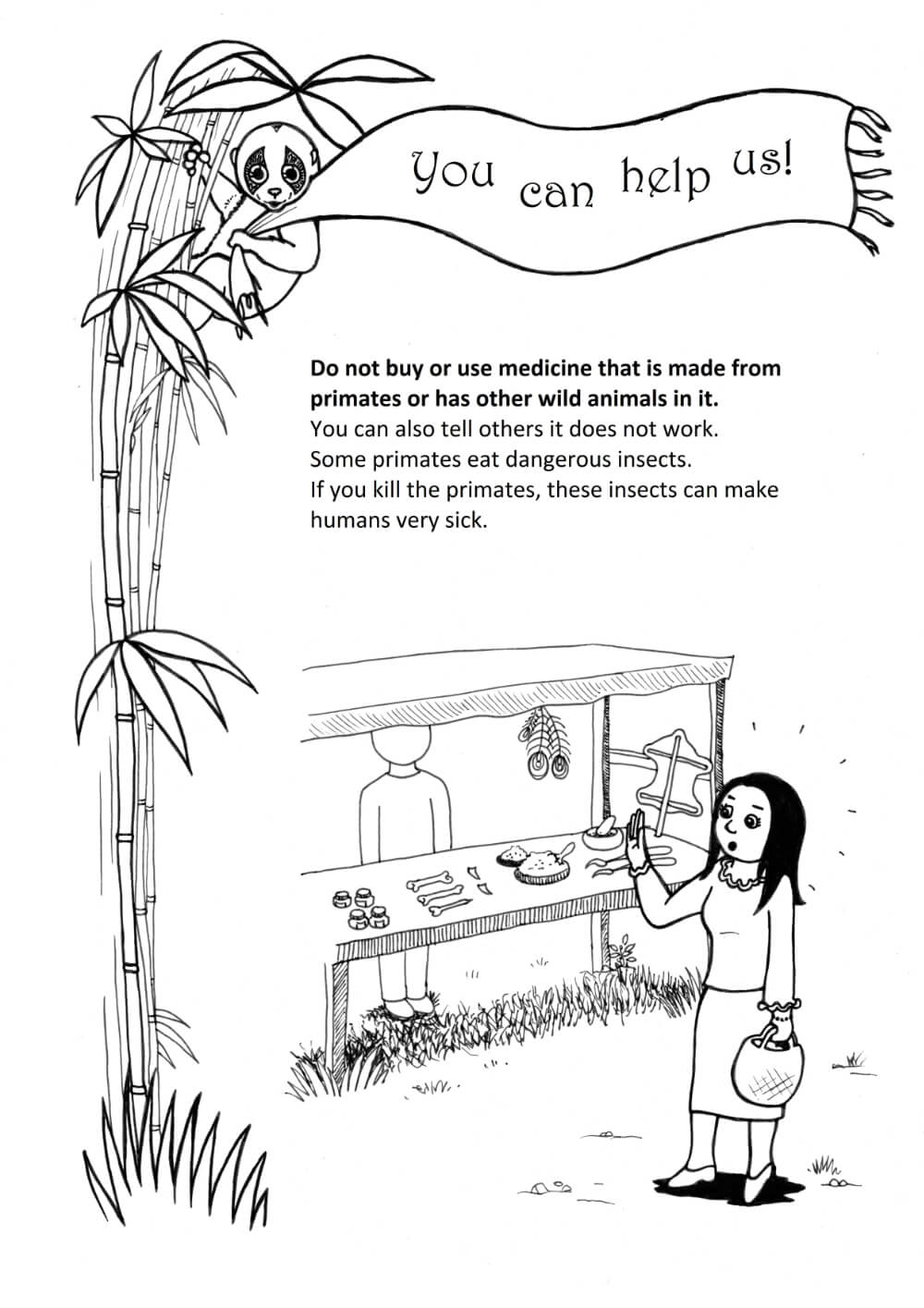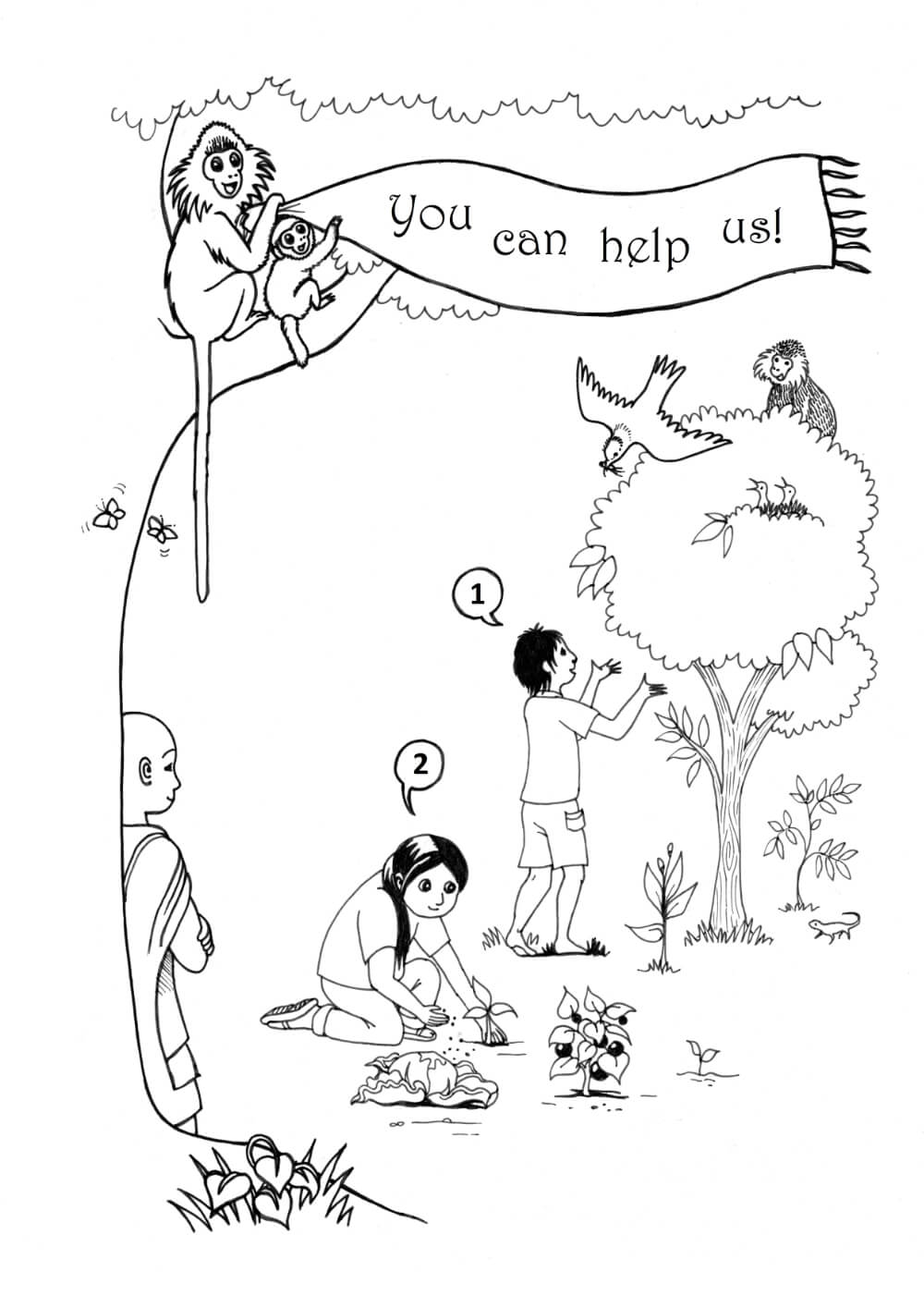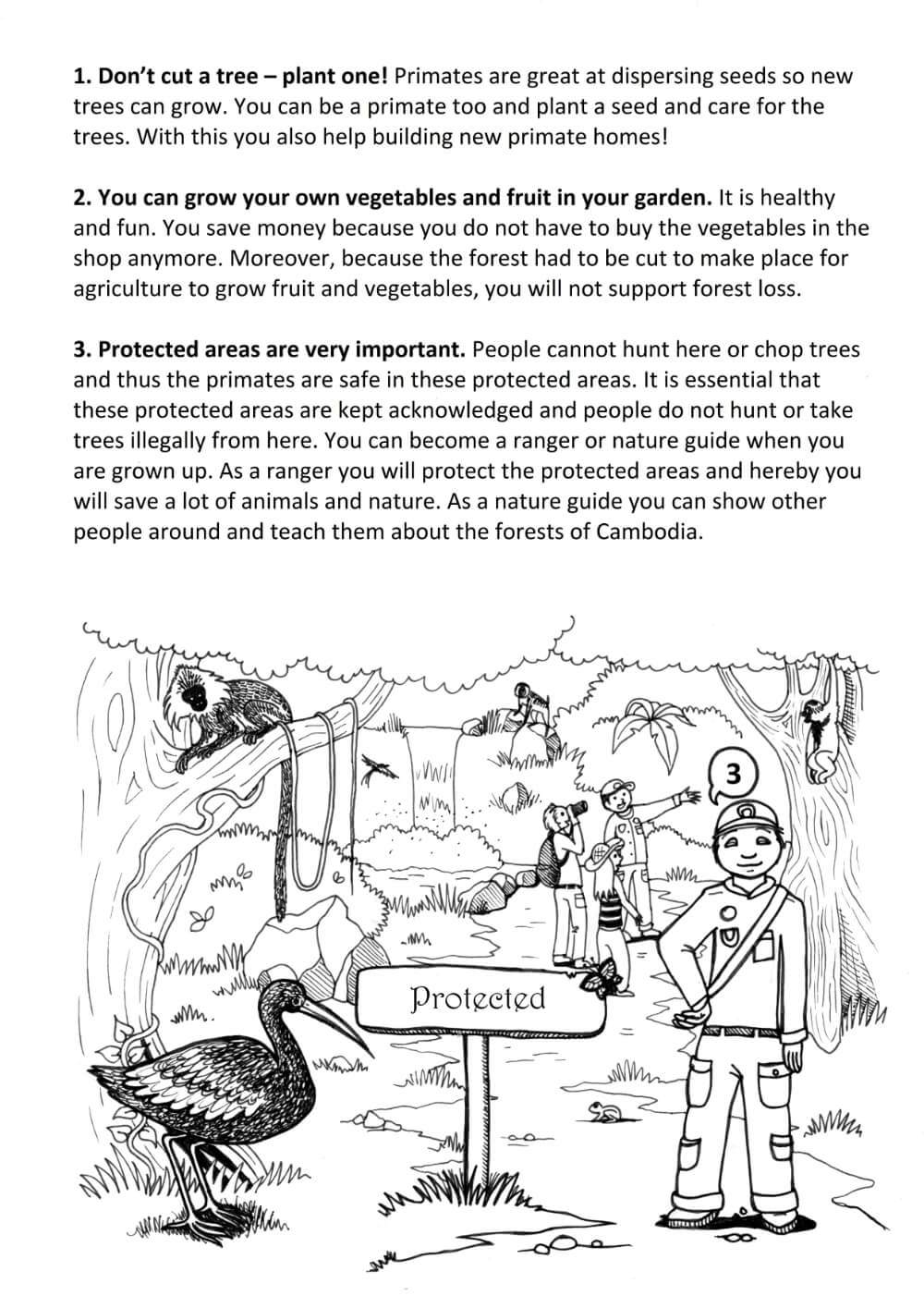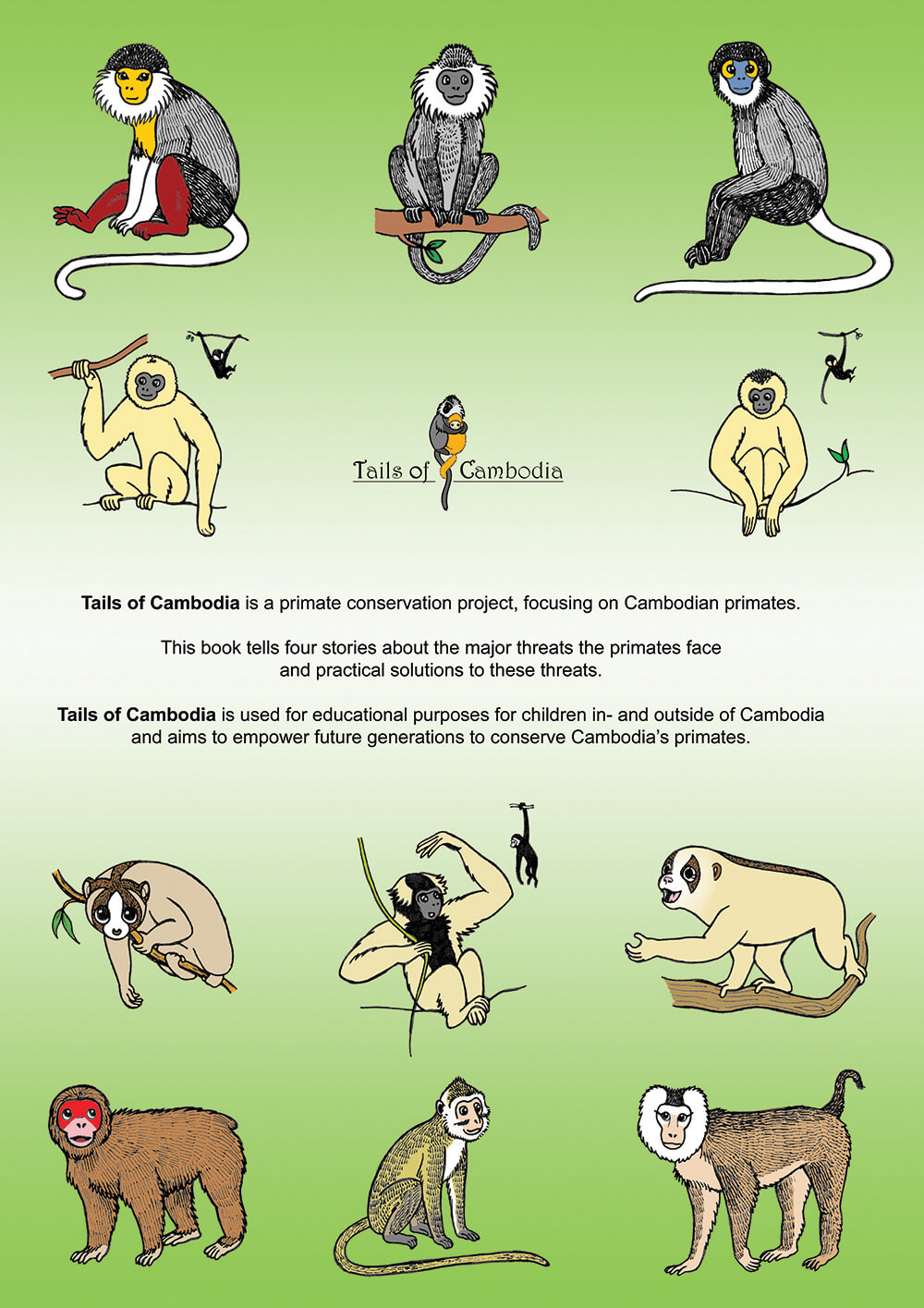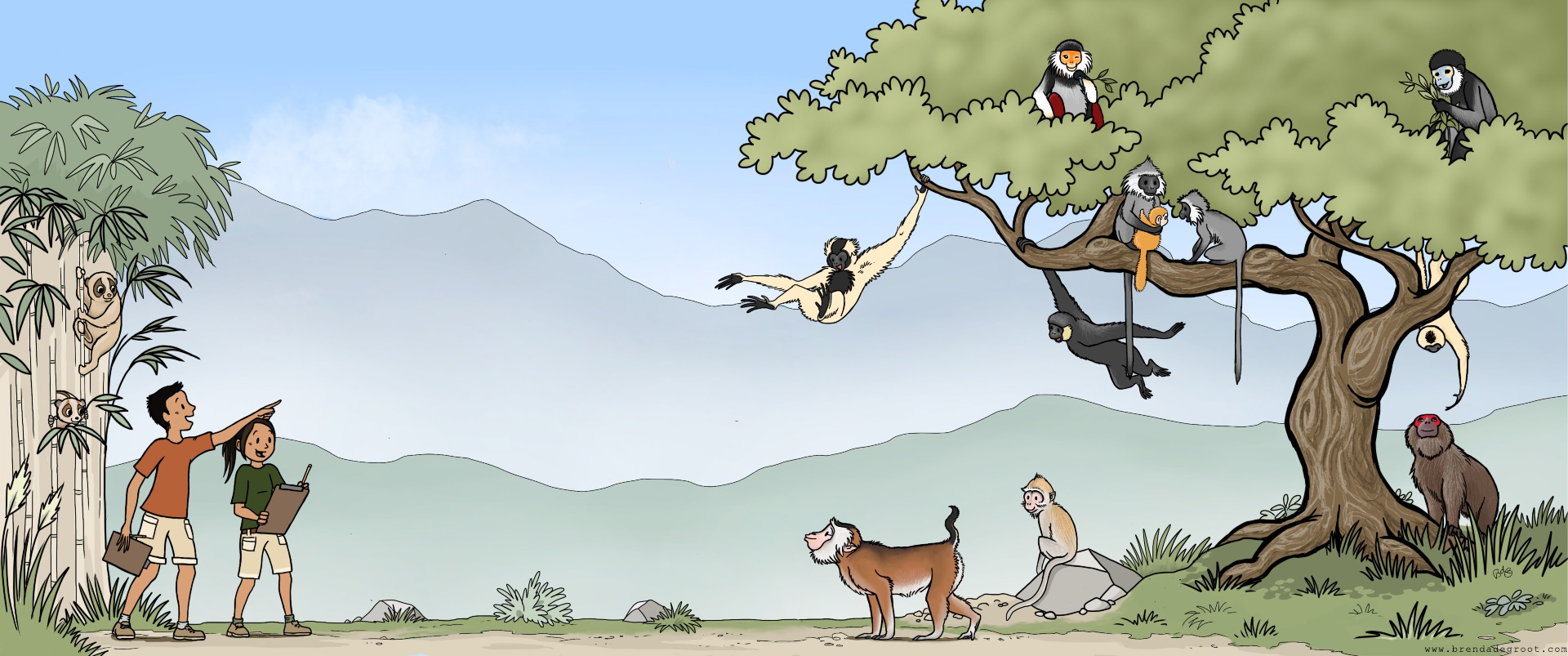
Tails of Cambodia
Education project for the conservation of Cambodia’s primates
I created an education project to empower local people to aid in the conservation of primate species in Cambodia. The project was part of my MSc in Primate Conservation at the Oxford Brookes University.
Here I show you what I did, why, where and how. I also gladly take this opportunity to engulf you with illustrations, photographs and stats (don’t worry, I made pretty graphs out of it).
I’m inviting you to hop on to the virtual plane to Cambodia,
the land of the 12 primates.

Introduction
Cambodia lies in what is called a ‘biodiversity hotspot’. There are 25 of those hotspots on earth, each of them accomodate a great abundance and variety of wildlife. All biodiversity hotspots together contain almost half of the world’s plant species and more than one third of the terrestrial vertebrate species, but cover only 1.4% of the total land area of the planet.
More than 50% of Cambodia is still covered in forest, and the country has the ability to significantly contribute to global biodiversity conservation. However, the rate of deforestation is high and has a detrimental effect on Cambodia’s charismatic and severely threatened mammal species, the primates.
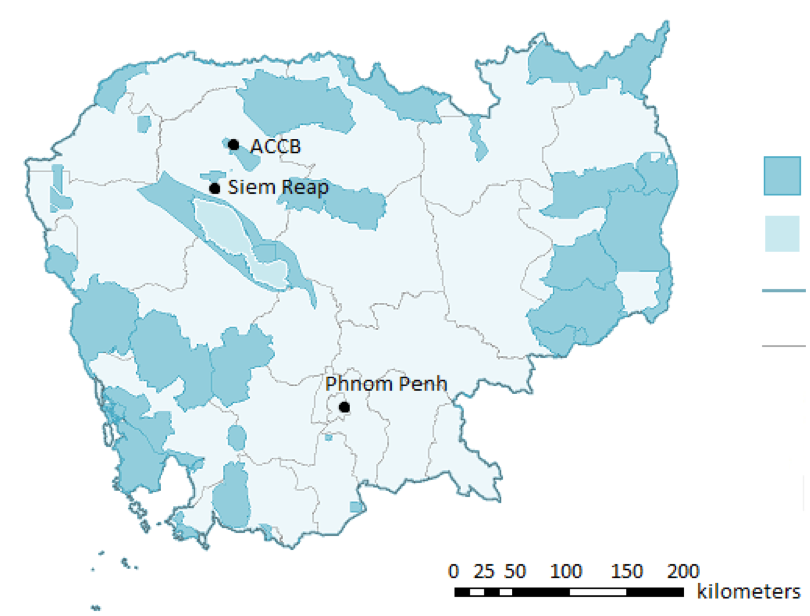
Primates of Cambodia
Cambodia is home to 12 primate species, of which 11 are threatened with extinction.
Photo credits, from first to last photo: [1] Tilo Nadler [2] Hoang Mai Thach – Shutterstock [3] Brenda de Groot [4] JJ Harrison [5] Ramki Sreenivasan [6] Rob Reintjes [7] Brenda de Groot [8] Jeremy Phan [9] ZooChat [10] Sancassania, CC BY-SA 3.0 [11] John B. Wilson – Flickr [12] Jeremy Holden.
Threats
The main threats to Cambodian primates – like all primates on Earth – are deforestation and hunting.
Forests are cut for timber and to make space for agriculture and human settlement. Deforestation destroys the environment primates live in, and by this the primates themselves. As the forest is getting more fragmented, people can easily access primate territories. The primates get hunted for meat, traditional ‘medicine’, or the wildlife trade.
Each primate species faces different threats. On the flip cards below you can discover them for yourself.
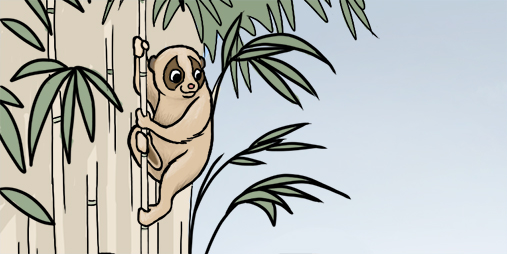
Lorises
Cambodia is notorious for hunting slow lorises for traditional ‘medicine’, as it is believed that ground-up loris is good for curing stomach pain.
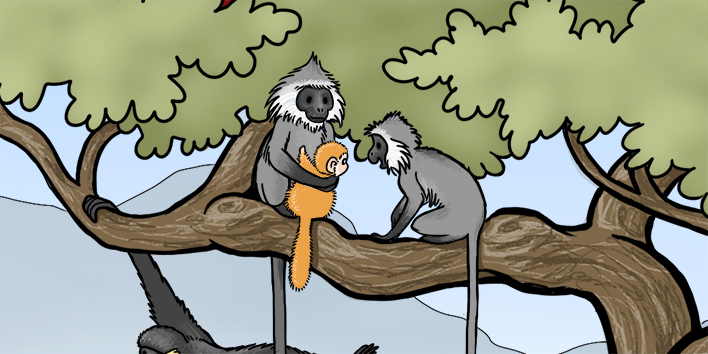
Colobines
Langur and doucs are killed for their meat and to make primate gelatin. The infants of killed mothers are kept as pets. In mangroves, langurs are hunted because it is believed they scare the fish away. Entire populations of these monkeys vanished.

Macaques
Macaques are hunted for their meat, and the infants are sold as pets on markets. Additionally, long-tailed macaques are captured for experimental purposes, even though large-scale ‘breeding farms’ exist.

Gibbons
Gibbons are reluctant to leave their habitat and strongly rely on evergreen forests to live. As forests are cut down, the apes have nowhere to go to, and are exposed to the elements – the human element in particular.

Cambodia is notorious for hunting slow lorises for traditional ‘medicine’, as it is believed that ground-up loris can cure stomach pain.
The macaques are actively hunted for their meat, and the infants sold as pets on markets. Additionally, long-tailed macaques are captured for experimental purposes, while also large-scale ‘breeding farms’ exist.


Langur and douc infants too make popular pets, and their families are killed for meat or to make primate gelatin. Entire populations vanished in habitats that would be highly suitable for these leaf-eating monkeys.
Lastly, gibbons are reluctant to leave their habitat and strongly rely on evergreen forests to live. As forests are cut down, the apes have nowhere to go to, and are exposed to the elements – the human elemant in particular.

Action to protect Cambodia’s primates
The excessive deforestation rates and the particularly high hunting pressure are wrenching Cambodia’s primate populations. Conservation measures are desperately needed – not only to protect primates as a species, but also as the individuals they are.
All animals have intrinsic value, and the right to live their lives unharmed. But they stand powerless against the almighty animal species we call human. Blessed with great intellect, it is our job to stop the exploitation of animals and their habitat, and protect them instead.
And by protecting primates, we can protect entire ecosystems.
The iconic primates make ideal ‘flagship species’. They attract the public’s attention and their support for conservation of their environment. Many more animal- and plant species that coexist within that environment can thereby thrive and survive.
All of this taken together, it is of vital importance that we protect Cambodia’s primates and the environment they call their home.

Education is the most powerful weapon to change the world.
– Nelson Mandela
Conservation education is key for long-term conservation of animal species and the environment they live in. Local people are often aware and concerned about environmental issues, but feel powerless as many lack the knowledge and/or skills to counteract the damage.
To empower local people to contribute to primate conservation, I developed an education project titled Tails of Cambodia. The goal of the education programme was to create:
1. A positive attitude towards primates
2. Knowledge about the threats that Cambodian primates face
3. Skills to solve these problems

Attitudes + Knowledge + Skills = Change
We need all three variables to be present to make a real change.
When a person cares about primates, knows what problems they face and what should be done to solve these problems, then we can book significant progress in primate conservation.
The education project is build on this philosophy.

What I did
I ran the project from the 15th of April to the 31st of July 2014 at Angkor Centre for Conservation of Biodiversity (ACCB), near Phnom Kulen national park.
I developed a children’s education program, carried out engaging ‘Miniclub’ sessions with local children, and created an illustrated children’s book.

Education program
Including a presentation, a lesson plan and complimentary materials for engaging activities. Available in English and Khmer.

Children’s book
Educational story book with large illustrations, providing information about Cambodia’s primates, the threats, and the solutions.

Miniclubs
Engaging children in a fun way to increase their awareness of and positive attitude towards primates and their protection.
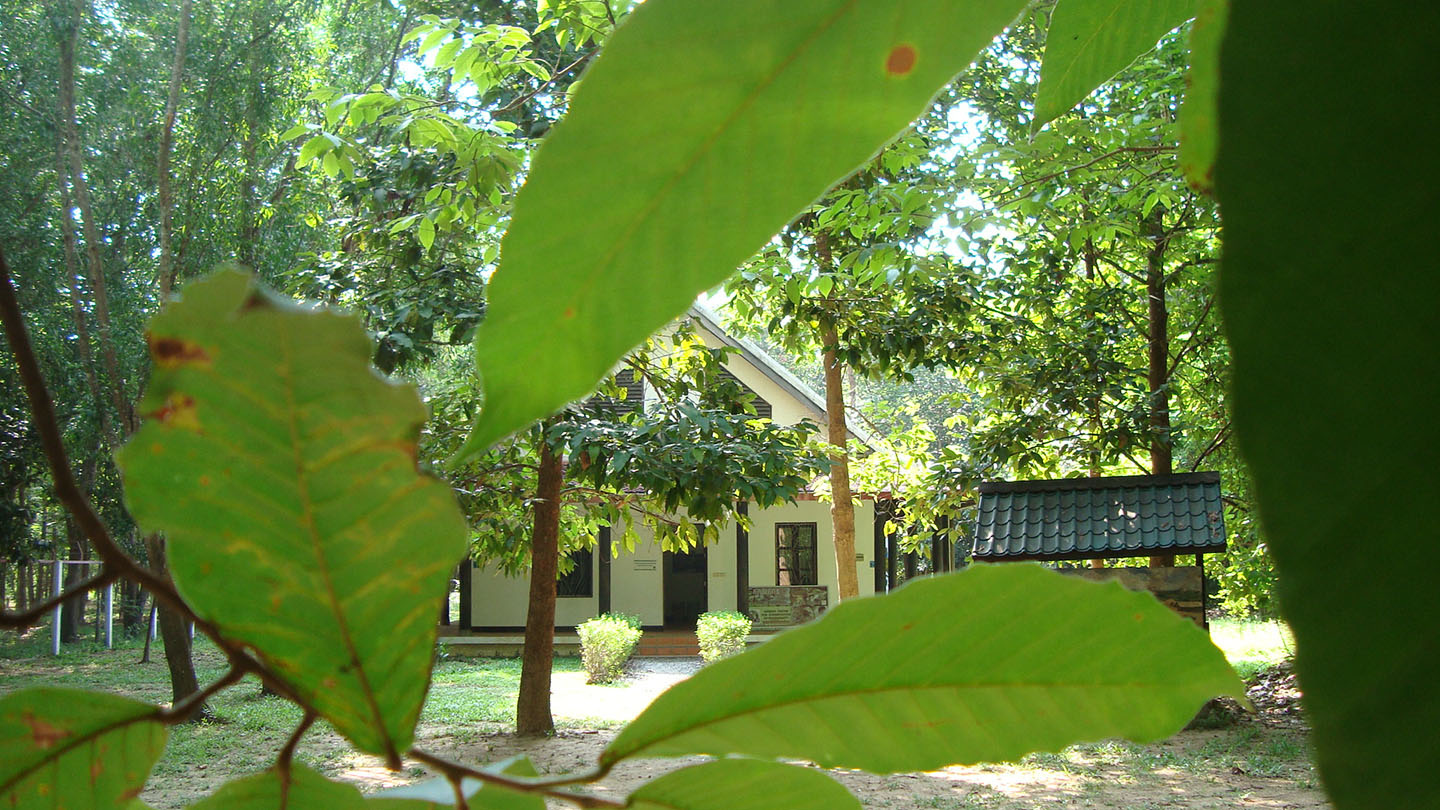
Education Program

The education program is a 3-hour long program on Cambodia’s primates and their conservation.
It included a lecture teaching about the ecology of primates, the threats they face, and the solutions to these threats which the children can carry out themselves (a.o. spreading the message or becoming a nature ranger). The program also included activities, of which one was an observation session at ACCB’s primates using a real ethogram!
The education program can be taught as a whole as a half-day session, or split up in two or three successive parts.
All materials were translated in Khmer and can be downloaded below. Please feel free to use the lesson plan for educational purposes, mentioning the source as follows: © Tails of Cambodia, Brenda de Groot – Oxford Brookes University.
Download Education Program (.pptx)
Miniclubs

The Miniclubs were informal engagement sessions with local children, to stimulate their interest in primates, connecting positive feelings towards them, and increase their motivation to conserve primates.
Each miniclub contained activities for all three learning styles:
1. Colouring and drawing for visual learners
2. Reading educational books for auditory learners
3. Playing primate-related games for action-oriented learners
I carried out the Miniclubs whenever I could. For example, I would join the ACCB team to rural villages for their Community Night Shows, and while they were setting up the equipment, I would run a Miniclub session with the children.

As a researcher, I love data, so I rated each Miniclub:
Through the engagement ratings, I found out that the children LOVED to colour, so that became my main approach. During Miniclub sessions, ACCB’s educators would casually walk by the children, explaining about primates and their behaviour.
One night at a particularly large village, I ran out of colouring sheets! Fortunately, I had a black marker on me, and we had packed an extra pile of blank paper. So I could just draw a few extra on the spot.
This had the benefit that children could pick their favorite primate (or other animal – tigers were highly requested) through pointing at the picture in one of the story books, which I then would draw. It turned out quite the event..!
World Environment Day
carried out the biggest Miniclub session during World Environment Day, the 5th of June. On this day, we invited children from surrounding villages to come and play environmental games at ACCB.
I decorated some small canvasses with Cambodian primates and other animals. The children were thrilled with the canvas colouring. Many of them refused to eat and drink, as all they wanted to do was finishing their painting!
I was able to fund the materials with the grants I received from conservation organisations (see them at the bottom of this page). I can say without doubt that the money was really put to good use!
Book

During my time at ACCB, I wrote, illustrated and printed a children’s book as part of the education project. Each child that participated in the education program could take one home.
Thanks to the conservation grants, I was able to print more than 800 copies of the book. This enabled me to also hand out books to children who didn’t attend the education program, like those who came to World Environment Day.
Tales of Cambodia
The purpose of the book is to continue where the education program ended: to build even more positive attitudes, knowledge and skills, and to reach as many children (and adults!) as possible to help protect the primates of Cambodia.
The book was printed in Khmer and English, to reach children both in- and outside of Cambodia. It can be used as a picture- or colouring book, or for education purposes.
Take a peek below or click here to see the full book.
Results

I evaluated the education program by using a pre- and post-test to measure the participants’ change in knowledge, attitude and skills concerning primate conservation. I also ran a control test with a group who followed a di!erent education class.
Below you see three graphs. The darker shades on top represent the participants’ scores on the post-test (that they filled out after the education program), and the lighter shades the scores on the pre-test (filled out before the education program).
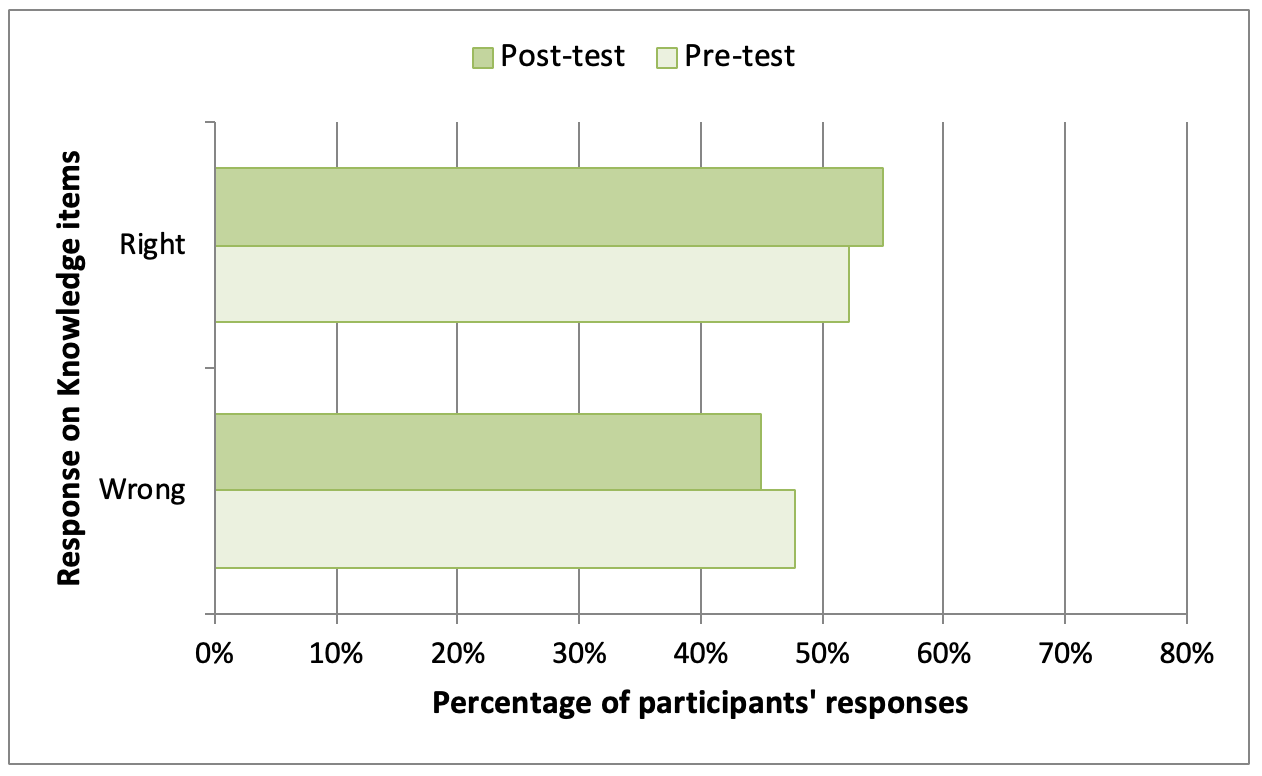

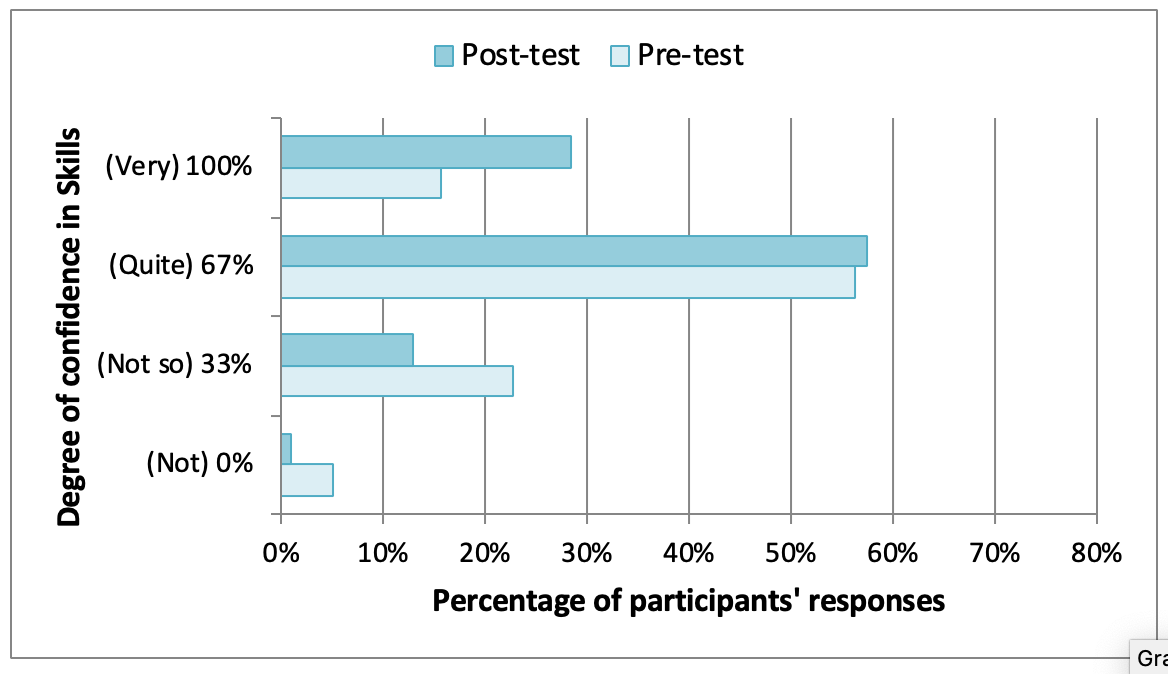
Participants scored significantly higher on Attitude and Skills on the posttest than on the pre-test. Although the participants did give more right answers on Knowledge questions on the post-test, the outcome did not reach significance.
If you are curious about the pre- and post-tests or want to use them yourself to evaluate the education program, you can go ahead and download them below:
Pre- and post-test (PDF)
Conclusion

By raising positive attitudes and skills, the education program increased the likelihood for behaviour change that benefits primate conservation. This project demonstrates that progress can be made even within a short amount of time. However, it’s the long-term conservation e!orts that make the most impact. Therefore I shared the education program and book with ACCB and other conservation organisations, enabling the opportunity for the project to have a long-term impact as well.
Cambodia’s forests and wildlife need protection more than ever before. My recommendation for future conservation efforts would be the following:
Empower local people
Many local people have the good-will to protect the environment around them, though a lack of education and resources is restricting them to act. One would set the stage for significant change when focusing on developing and strengthening people’s basic education skills first, such as reading, writing and the English language. The next step then, is to provide local people with resources and information about wildlife and the environment, so they can increase their conservation knowledge and skills.
Build on success
It is well-known that a few good long-term projects make more impact than many small ones. Therefore it is better to continue and add to established conservation projects rather than to ‘reinvent the wheel’.
Educate the educators
Besides empowering local communities, we should also empower ourselves. Conservation education is a small discipline, and can greatly benefit from the expertise of other fields of study. As a psychologist, I would strongly recommend conservation educators to look into the social psychology literature. It is the field of changing attitudes, influencing behaviour and discovering people’s motivations. These topics are of major importance to conservation education, and knowledge thereof can lead to powerful conservation action for primates, wildlife and the environment as a whole.

Some final words

It is of crucial importance that Cambodia’s next generation genuinely cares for nature. Not only so its resources can be used for a longer period of time, but ideally for the sake of all other sentient beings inhabiting that natural environment. This ethical approach, which I define as sentientism, should be sprouting far beyond philosophy, academia and Cambodia, and have its vines cross both interdisciplinary and international borders.
Nature teaches us that if we want something to grow, we must first plant its seeds. Now is the time to spread our love for nature. It is education that is the answer to the questionable future of our Earth’s biodiversity, because
In the end we will conserve only what we love,
we will love only what we understand
and we will understand only what we have been taught.
– Baba Dioum
Acknowledgements
My forever gratefulness goes to these incredible organisations and the people behind them, who enabled me to create and implement this project. Without their support, Tails of Cambodia would surely not have come this far. Thank you.


